The Hilton Head Sun



By Sasha Sweeney Editor
The Hilton Head Island Town Council approved a series of measures during its June 17th meeting aimed at bolstering public health, environmental standards, and long-term infra structure planning.
Among the most notable actions, council amended an integrated pest management (IPM) policy, establishing Hilton Head as the first municipality in South Carolina to adopt an “organic-first” approach to pest control. The revised ordinance, originally passed in October 2024, prioritizes non-chemical and environmentally responsible methods, and ensures transparency to the public regarding treatment plans.
money will be divided between Hilton Head Island Fire Rescue and the Low Country Alliance for Healthy Youth.
Fire Rescue will receive $93,859.35 to launch a Substance Abuse and Mental Health Management Team. The program aims to identify individuals at risk for opioid use disorder and co-occurring mental health issues, offering outreach, peer support, and referrals.

The remaining $238,005 will support the alliance’s prevention efforts, including media outreach, drug disposal education, mental health training, and youth engagement through schools and faith-based programs.
ed to benefit the district.
• Temporary construction access was approved through Islanders’ Beach Park. The access will allow state-permitted sand relocation efforts for the Admirals Row, Ocean Villas, and Tennis Villas homeowners associations.
Following an executive session, council appointed several residents to serve on various town boards, commissions and advisory committees:
• Planning Commission: Margaret Hewitt (2026), William Redman (2028), Jeff Turnbull (2028)
• Design Review Board: Cathy Foss (2027), Megan Fitzpatrick (2028)
• Board of Zoning Appeals: Jeffrey Greene (2027), Peter Kristian (2028), Robert Johnson (Architect, 2028), Kathryn Bayless (2028)
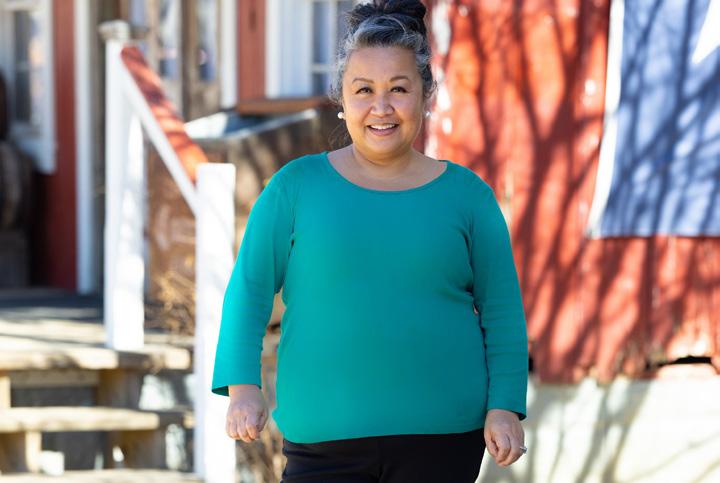
Council also approved new beach parking fees effective June 24th. The $20 flat rate for weekend parking was eliminated and replaced with a $5-per-hour fee. On weekdays, the existing $15 daily cap was removed, maintaining the $3-per-hour rate. Parking enforcement will remain daily from 7 a.m. to 5 p.m., while park hours are unchanged at 6 a.m. to 10 p.m. Parking at Coligny Beach remains free and is not affected by these changes.
In a unanimous vote, council approved a consolidated request for $331,864.35 in opioid recovery funding from the state’s Guaranteed Political Subdivision Sub fund. The
The council also held the first reading of proposed updates to the municipal code governing its committees. If adopted, the changes would clarify how committees are formed, offer more consistency, and improve flexibility in their operations.
Several infrastructure-related items were also addressed:
• Council adopted updates to the 2020 Lowcountry Natural Hazard Mitigation Plan and Repetitive Loss Area Analysis, required for participation in FEMA’s Community Rating System.
• Officials ratified redevelopment projects under the Tax Increment Financing (TIF) Redevelopment Plan. These include work in adjacent areas expect-
• Construction Board of Adjustments and Appeals: Angelina Carpenter (2029), Charles Fauer (2029), Neil Gordan (2028)
• Parks and Recreation Commission: John Parsons (2028), Charles Quigg (2028)
• Gullah Geechee Historic Neighborhood CDC: David Ames (2028), Sarah Eisner (2028)
• Recreation Board of Directors: Ray Kisiah (2029)
• Beaufort County Stormwater Utility Board: Jeff Netzinger (Ex Officio, 2029)
The next Hilton Head Island Town Council meeting is scheduled for July 15th at 3 p.m. Meeting materials and recordings are available on the town’s website hiltonheadislandsc.gov and YouTube channel.


o further enhance orthopedic options for patients throughout the Lowcountry, Beaufort Memorial has added an experienced surgeon to its team at Beaufort Memorial Orthopaedic Specialists.
Dr. Cory A. Messerschmidt brings his expertise in joint preservation, replacement and robotic surgical techniques to the practice, seeing patients in both Port Royal and Okatie. Fellowship-trained in sports medicine, he also performs minimally invasive arthroscopic procedures such as ACL repairs, meniscus preservation and shoulder arthroscopy for both adult and pediatric patients.
Dr. Messerschmidt joins the practice from his role as an orthopedic surgeon at Tallahassee Orthopedic Clinic in southern Georgia. His interest in medicine developed in high school, when he volunteered at a hometown emergency room in Virginia with his father.
Board-certified Orthopedic Surgery
Fellowship Training
Sports Medicine
Emory University Atlanta, Ga.
Residency Orthopedic Surgery
Medical University of South Carolina Charleston, S.C.

During his sports medicine fellowship at Emory University, Dr. Messerschmidt worked with professional sports teams such as the Atlanta Falcons and NCAA collegiate teams including Georgia Tech. In recent years, he has worked closely with local high school athletes, helping them recover from sports-related injuries and make a confident return to activity.
Doctor of Medicine
Eastern Virginia Medical School Norfolk, Va.
Dr. Messerschmidt joins boardcertified, fellowship-trained orthopedic surgeon Vandit Sardana, M.D., MSC, FRCSC at the Orthopaedic Specialists practice.

By Ray Warco Contributor
We live in one of the most beautiful and unique places on earth—a paradise that many of us are proud to call home. But even paradise isn’t immune to change. Our beloved corner of the Lowcountry is experiencing growth and development at an unprecedented pace. From rising population numbers and infrastructure demands to environmental concerns and the evolving needs of diverse communities, the decisions we make today will echo for decades to come.
Join the conversation
By collaborating with neighbors, local organizations, businesses, and government leaders, we can ensure that our region continues to thrive while staying true to its character. The Greater Island Council of Hilton Head Island and Bluffton (GIC) is committed to fostering discussions and advocating for quality-of-life outcomes. We invite you join us, attend
our monthly speaker meetings, share your thoughts, and participate in one of our committees. Whether you’ve lived here your entire life or just moved to the area, your perspective is vital.
Our members are participating in the discussions and looking for solutions for affordable childcare, coordinated regional planning, answers for the next level of recycling and solid waste disposal and the future of our parks.
But these are just starting points. You may see other priorities that deserve attention, and your insights could shed light on issues we haven’t yet considered.
• Development: How do we balance economic growth with the preservation of our natural beauty and cultural heritage?
• Arts & culture: How do we grow environmentally sustainable industries like the arts, culture and historical sites which improve our quality of life.
• Infrastructure: Are our roads, bridg-






es, and public services prepared to handle increasing demands?
• Housing: How do we address affordability and accessibility while maintaining the character of our neighborhoods?
• Environment: What steps should we take to protect our waterways, marshlands, and wildlife from the impacts of climate change and overdevelopment?
• Schools: How can we ensure that our schools and institutions are equipped to prepare future generations for success?
What matters most to you
We want to know what you think are the most pressing issues that will define our shared future? What steps should we, as a community, take to preserve what makes our home so unique while preparing for the changes ahead?
The Greater Island Council of Hilton Head Island and Bluffton, a non-partisan, citizen-led organization, is dedicated to advocating for initiatives and policies that shape the quality of life in our region. We believe that listening to the voices of our neighbors is the first step in creating proactive, effective solutions. That’s why we’re asking you to join the conversation. Let’s work together to ensure that the next decade is one of smart, sustainable, and inclusive growth for Beaufort and Jasper counties.
Share your thoughts with us at GreaterIslandCouncil.com/contact-us.
Ray Warco is the Board Chair of the Greater Island Council of Hilton Head Island and Bluffton.

Current Circulation Via USPS is 26,276
General Manager
Melissa McCullough melissa@blufftonsun.com
Editor
Sasha Sweeney editor@blufftonsun.com
Page Designer
Cary Howard cary@blufftonsun.com
Graphic Designers
Wendy Price
Janelle Medeiros
Advertising
Mary Ann Kent, Sales & Marketing Manager, 843-575-4151
BJ Frazier, 843-422-2321
Claudia Chapman, 814-434-3665
Mary Pat Gifford, 912-414-7122
Contributors
Alex Barry
Dr. Cassandra Beard
Abby Bird
Rev. Dr. Jon R. Black
Rep. Jeff Bradley
Lisa Hostetler Brown
Chad Cannon
Ryan Chowansky
Shoranda Clark
Chip Collins
Danie Connolly
Collins Doughtie
Thomas Dowling
Dr. Ronald Finger
Kevin Fitzpatrick
Emma June Grosskopf
Annelore Harrell
Glenda Harris
Dr. Jean Harris
Dr. Kenneth Horup
Justin Jarrett Rev. Therese
Donlan Lee
Tamela Maxim
Dr. Matthew Mastrorocco
Mayor Alan Perry
Lindsay Perry
Dan Prud’homme
Leslie Rohland
Cinda Seamon
Rosemary Staples
Paul Tollefson
Matt Uppenbrink
Sandro Virag
Ray Warco
Mark Winn
Melissa McCullough PO Box 2056, Bluffton, SC 29910
843-757-9507, 843-757-9506 (fax)
Physical address: 181 Bluffton Rd., Ste F103-2 Bluffton, SC 29910
BlufftonSun.com

By Mayor Alan Perry Contributor
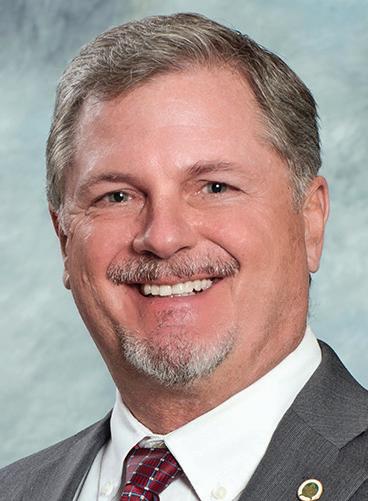
Summer. For many of us it’s our favorite time of the year. And I couldn’t agree with author Kellie Elmore, well, more: “Some of the best memories are made in flip flops.”
Lowcountry summers are the why behind our annual, robust visitor brigade. They bring that irresistible combination of sweet, seasonal fruit, frothy cold brews, warm evening breezes and refreshing splashes in our local waterways. And it’s also a time to come together as a community and celebrate the freedom we enjoy today because of those who came before us.
The July 4th holiday and our peak beach season is always a special time for family traditions on Hilton Head Island. For those who love the sound of freedom while enjoying a beach day, there’s the annual Salute from the Shore flyover that starts in North Carolina and ends here in the Lowcountry at 1:30 p.m.
In addition to the rousing July 4th fireworks displays at Harbour Town in Sea Pines and Shelter Cove Marina, residents and visitors alike are free to “ooh and ahh” at firework displays during Shelter Cove Marina’s Harbourfest on Tuesdays throughout the summer.
For those brave enough to stand our signature humidity, there’s the USA 5K at Coligny Beach and the Firecracker 5K at Honey Horn, both on the morning of July 4th.
Even more family-friendly fun that also supports our local community can be found at these upcoming events:
• Party in the Park, bi-weekly Thursdays, now through July 24 from 6-8:30 p.m. at Lowcountry Celebration Park.
• 2025 Jazz in the Park Series, bi-weekly Tuesdays, now through Sept. 2 from 7:30-9:30 p.m. at Lowcountry Celebration Park.

• Movie Nights in the Park, Thursdays, now through Aug. 14 from 8:30-10:30 p.m. at Shelter Cove Community Park.
• Sunset Celebrations, Fridays, July 11Aug. 15 from 7-10pm at Shelter Cove Community Park.
• Summer Jams, July 4 & Tuesdays, July 8-29 from 5:30-9:300m at Shelter Cove Community Park.
Last month, we observed the national Juneteenth holiday (June 19th) and commemorated the end of slavery in the U.S. During several days of festivities and fellowship at the Historic Mitchelville Freedom Park, I was honored to share a proclamation with attendees honoring the resilience and contributions of all Black Americans, and in particular the African Americans who established the first self-governed freedmen’s community in the nation.
According to exploremitchelville.org, “Mitchelville became a vibrant, self-governed community, both defined and accentuated by the customs and cultures of native islanders, the Gullahs, and those brought to America from a multitude of countries and islands. At its height, Mitchelville boasted 1,500 to 3,000 residents and demonstrated freedom and opportunity for African Americans diverse in backgrounds and origins.”
The Town proudly supports Mitchelville Park’s ongoing endeavors to educate and inspire residents, visitors, and others to learn and grow from efforts made to preserve this rich cultural history and Gullah Geechee community traditions, right here on Hilton Head Island.
Alan Perry is the mayor of the Town of Hilton Head Island. AlanP@hiltonheadislandsc.gov
"I have experienced positive physical and emotional changes; I have more confidence and self-esteem in my daily life."
-Debbie, actual patient

By Rep. Jeff Bradley Contributor

For the past two decades, South Carolina has been welcoming a surge of new residents and industries thanks to its pleasant environment and business-friendly climate.
Let’s review your smile goals and concerns like gaps, crowded teeth, cross bites, or shifted teeth, like our patient, Debbie, experienced.
Schedule your complimentary virtual smile design and receive $500 off any Invisalign booked by September 15, 2025!
Bluffton | 843.706.3800
Hilton Head | 843.682.4601
Between 2010 and 2022, the Palmetto State’s population grew by 14%, increasing from 4.6 million to more than 5.2 million residents. South Carolina has consistently ranked among the top ten fastest-growing states in the USA. Our population growth rate of 1.7% in 2024 was one of the nation’s highest, with an estimated 2.05 people moving in for every one person moving out.
Over the past decade, key business sectors, including construction, leisure and hospitality, as well as professional and business services, have experienced growth of over 30%. Meanwhile, manufacturing, encompassing the automotive and aerospace sectors, has advanced rapidly, with employment doubling between 2010 and 2020.
Moreover, the influx of new businesses moving into South Carolina over the past decade, coupled with the state’s growing population, has placed significant pressure on our existing electrical infrastructure. And, without new reliable sources of power, our economic progress and quality of life could be at risk.
That’s why the South Carolina General Assembly, comprising both the House and Senate, has been spending long hours over the past two years studying our state’s energy needs and preparing a
strategic path forward to address the anticipated new growth.
The result is the Energy Security Act (House Bill 3309) introduced by Speaker Murrell Smith and passed by the House and then the Senate. This legislation has enabled a critical partnership between state-owned utility Santee Cooper and Dominion Energy South Carolina to construct a new, efficient natural gas combined-cycle power plant at the former Canadys coal-fired power station, located alongside the Edisto River in Colleton County, near Walterboro.
This collaboration will save money, leverage existing infrastructure, and ensure reliable power for customers of both utilities. It also lays the groundwork for 1,800 megawatts of new solar power, expanded battery storage, and more innovative demand-side energy management over the next decade.
The new Energy Security Act supports a balanced energy portfolio with critical tools to meet the growing demand. It streamlines – but does not eliminate – regulatory oversight, ensuring that utilities must still obtain all required permits and approvals. It also sets specific deadlines for decisions to avoid costly delays.
The legislation is not about shortcuts. It’s about planning ahead, because even ordering a power turbine today takes four years. With more than 20 major companies currently considering operations in South Carolina, we must now act to ensure reliable, affordable energy for the long term.
I am proud to support our legislative leaders, plus Governor Henry McMaster, who are focused on this vital issue. The Energy Security Act is a wise investment in our energy future, and I will continue to work to ensure we stay ahead of the curve.
Jeff Bradley is the representative for District 123 in the State House of Representatives.








40 FOLLY FIELD ROAD #B320
MLS #446698
$298,800
Incredible rental opportunity or pvt vacation villa for your own enjoyment, this villa has amazing updated features. Kitchen is spectacular w/ generous, updated design w/ extra cabinet storage, pantry, built ins, cool banquette, granite counters & glass tile backsplash.

40 FOLLY FIELD ROAD #A309
MLS #450302
$283,000
Beautiful tile throughout, contemporary and modern, the bath has floor to ceiling tile, glass tile accents and a fabulous walk in shower. Unit has an open floor plan, modern kitchen design w/granite tile counters & glass tile accent walls.

40 FOLLY FIELD ROAD #B334
MLS #452840
$325,000
Second back from front of B building. Fantastic ocean, marsh and lagoon views. Open bedroom for greater comfort. Lovely shower with seat. Sit on balcony and hear the waves. Extra cabinets, ice maker to name a few pluses.

40 FOLLY FIELD ROAD #C348
MLS #452876
$290,000
**Seller offering $5,000 Incentive to buyer for closing costs at closing**GORGEOUS OCEAN VIEW CONDO! Come see for yourself!! 3rd Floor, 1 bed, 1 bath, and fully furnished!
Features include: Stainless steel appliances, granite counters, elegant hall closet system.




By Mark Winn Contributor

Good estate and asset protection planning with proper use of trusts can neutralize many threats, namely: Loss of assets to--taxes, lawsuits, probate fees & costs, family disputes, loss to in-laws if a child becomes divorced.
Do you have a married child who may become divorced later in life? Unfortunately, in modern times the risk of divorce is high. Some statistics indicate that nearly 50% of newly married couples will divorce later in life. Leaving assets to them in trust, instead of outright, can protect these assets from claims of alimony and division in a divorce. You can then direct the assets will stay in your bloodline and not go to your in-law.

Do you have a child or grandchild with “special needs?”
If there are government benefits a loved one receives, then leaving assets to them in trust, instead of outright, can help pre-



serve these benefits for your loved one.
Do you have a child or loved one who has demonstrated an inability to manage assets? Perhaps, they are in serious debt or have a gambling problem.
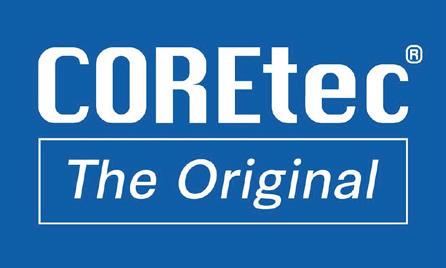
Leaving assets to them in trust, instead of outright, can protect these assets from irresponsible behavior. Also, you can provide them a stream of income and not stifle their initiative.
Do you have a successful child who is in a “high risk” profession? Perhaps, you have a daughter who is a surgeon. This profession brings with it a significant exposure to liability from lawsuits. Leaving assets to such a child in trust, instead of outright, can protect these assets from future lawsuits.
While there are many tax related benefits that can be achieved with proper estate planning and use of trusts (like avoiding estate taxes and deferring income taxes), a carefully tailored trust can accomplish many non-tax objectives, see above, that will protect and preserve your family wealth.
Mark F. Winn, Master of Laws (LL.M.) in Estate Planning, a local asset protection, estate planning and elder law attorney. www.mwinnesq.com




















By Sasha Sweeney Editor
Local officials confirmed two shark bite incidents in June, both resulting in non-life-threatening injuries and prompting renewed focus on beachgoer safety.
The first incident occurred June 17th at Sea Pines Resort, where a 12 year old girl suffered a shark-inflicted laceration to her lower right leg. She was treated by Shore Beach Services personnel and Hilton Head Island Fire Rescue before being airlifted to a Savannah hospital. Authorities later described her condition as stable, noting the injury was not life-threatening.
Just five days later, on June 22nd, a teenage girl was bitten at Coligny Beach Park. The injury—also to the leg— was non life-threatening. She received on scene care before being taken to a local hospital.
In response, Hilton Head Island Fire and Rescue spokespersons emphasized that both beaches were immediately cleared and relevant stretches of water were closed for a time. Officials stressed the dynamic nature of ocean conditions and confirmed that Shore Beach Services is maintaining vigilant marine life monitoring throughout the busy summer season.
Shark bites in South Carolina remain rare. State Department of Natural Resources statistics indicate just about four such incidents occur annually.
Still, recent activity corresponds with a national trend: early summer sees heightened shark presence near shorelines, often as sharks follow baitfish into shallower waters. Conservation success has rebounded fish stocks, increasing
marine stability—and shark movement—near beaches.
Beach safety experts from American Lifeguard Association and local authorities recommend:
• Swim near lifeguard stands and avoid isolated areas
• Don’t swim alone, especially in murky water or low light
• Avoid dawn and dusk hours, when sharks are most active
• Steer clear of areas with splashing fish, which may attract predators
• Avoid shiny jewelry and erratic movements that could mimic prey
Experts also suggest that signs of baitfish—such as diving birds—may signal increased shark presence; beachgoers should leave the water promptly if observed.
Lifeguards from Shore Beach Services are trained to watch for marine predators and will clear beaches when sharks are near. If you spot a shark exit the water calmly and quickly.
If bitten, apply pressure to control bleeding and seek immediate medical help.
Hilton Head attracts nearly 2.8 million visitors annually. Despite the rare bite incidents, tourism figures have not declined this season. Officials emphasize that increased shark presence is a sign of a robust marine ecosystem—not an invitation to panic.
Bottom line: Shark encounters remain highly uncommon. Still, vigilance—especially during peak feeding times— adds an important layer of safety. Swim near lifeguards, avoid risky conditions and respect the ocean’s unpredictability. By following guidelines, beachgoers can enjoy Hilton Head’s waters while minimizing risk.






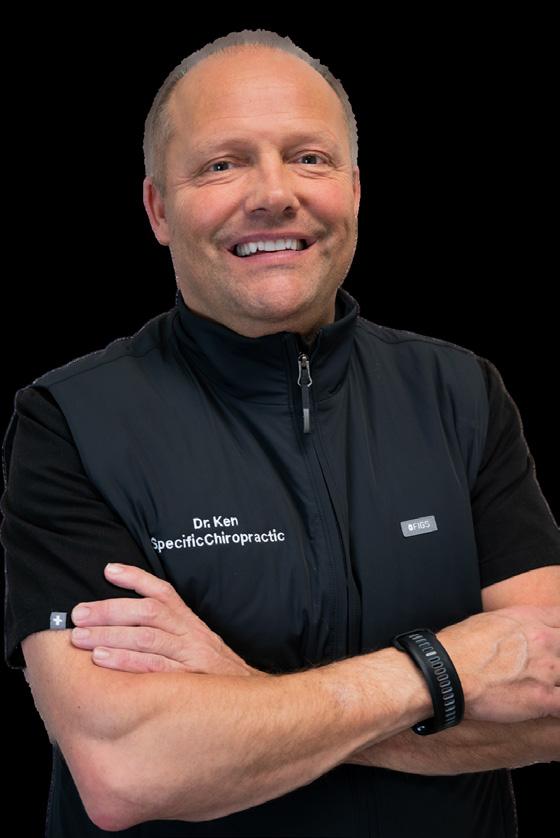
By Dr. Kenneth Horup Contributor

Getting through the day with nerve pain is tough. But for a lot of people with neuropathy, the real trouble starts at night — just when your body should be relaxing. Weirdly enough, you might feel fine during the day, only to get hit with burning, tingling, cramping, or that strange restless feeling in your feet right when you’re trying to fall asleep. Why does that happen? One big reason is circulation. When you lie down, blood flow to the feet can slow down, and that’s bad news for your nerves. Less blood means less oxygen and fewer
nutrients getting to the nerves, which can make symptoms worse when you’re trying to rest.
There are other things that can make it worse too — dehydration, blood sugar spikes or dips, and stress (thanks, life). But here’s the real kicker: if you have neuropathy, those things aren’t your biggest problem — they’re just pouring gas on the fire.
Yes, sleep matters — but it’s not a magic cure. Sleep is when your body does its repair work, especially the nervous system. During deep sleep, blood flow improves, inflammation goes down, and the brain kicks in to do some much-needed nerve repair. But if you’ve got neuropathy, your nerves are already overwhelmed. Poor sleep doesn’t just leave you groggy — it adds pressure to a system that’s already limping along.
Many people try the follow the usual advice— avoid caffeine, dim the lights, try magnesium, turning off your phone or drinking a glass of water; but if your
nerves are already damaged, it’s going to take more than that. And all of that’s helpful…if you’re not already dealing with nerve damage. But if your neuropathy has progressed past the early phase, those tips might not be enough to move the needle.
You don’t just need better sleep. You need a real plan.
If nighttime nerve pain is messing with your rest, it’s time to stop guessing. You need answers — not just more pillows or bedtime teas.
Here’s what matters:
• How far has your neuropathy progressed?
• What phase are you in?
• And most importantly — is there still time to help the nerves recover?
There’s a window where the nerves can still heal — but it doesn’t stay open forever. If too much damage has already been done, small changes like drinking more water or sleeping longer probably aren’t going to cut it. That’s why it’s so
The Seabrook offers premier senior independent living on a lush 21-acre campus just 0.8 miles from the ocean. Enjoy daily meals, social activities, transportation, a pool, and onsite medical care. With a clubhouse, fine dining, and pet-friendly policies, The Seabrook is where comfort, community, and care come together.

Your Hilton Head Island Insider.
With more than 30 years of experience in the local real estate market, Andy Twisdale brings unmatched knowledge and insight to every transaction. As a seasoned Realtor, he has not only witnessed but helped shape Hilton Head Island’s growth, making him an indispensable guide for both buyers and sellers navigating the market.

important to take your symptoms seriously, especially if they’re keeping you up at night.
You’re not alone. And, you’re definitely not hopeless
Go see your physician to get an evaluation. There are safe, non-invasive treatments that can increase blood flow, lower inflammation, and support actual nerve healing. But none of that happens unless you start with an evaluation.
So yes, sleep matters — but let’s make sure your nerves aren’t quietly screaming while you’re trying to count sheep. You don’t have to suffer in silence (or in socks). The sooner you find out what’s going on, the better chance you have to feel like yourself again — both day and night.
Dr. Kenneth Horup, DC is a Chiropractic Physician at Discover Specific Chiropractic, Board Certified in Neuropathy.

Estate sale! Spacious 3BR+den, 2BA top-floor condo with 40-ft balcony, new HVAC, W/D, and $40K+ in updates. Furnished (minus personal items), pet-friendly, no rentals. Just 0.8 miles to the beach—retain equity, don’t rent!
Top-floor 2BR/2BA furnished unit with lagoon-view balcony, wood floors, updated kitchen and baths, W/D, built-ins, and spacious dining. Sunlit and serene. Pet-friendly, no rentals. Equity ownership—0.8 miles from the beach!



Because once just wasn’t enough. Discover award-winning independent living at The Seabrook. Call today to learn why this coastal community should be your next, and best, retirement chapter.

By Sasha Sweeney Editor
When Kathy Strong was 12, she received a POW/MIA bracelet engraved with the name of Sgt. 1st Class James Leslie Moreland, a Green Beret missing since Feb. 7, 1968, during the Vietnam War.
“Everyone in my seventh grade English class had one, every single student,” said Strong. The bracelet was part of a national movement started in 1970 by student group Voices in Vital America (VIVA), urging wearers to keep them on until the soldier named was accounted for.
Unlike many, Strong kept hers on for 38 years.
“I really didn’t know anything at all about him for over two years,” she said. “In 1975 my mom wrote to VIVA asking for more information and they sent me a short biography and a photo of him.”
Strong’s vow ended May 14, 2011, when Moreland’s remains were positively identified. At his funeral, she placed the bracelet on the left sleeve of his dress uniform.
“That was a very emotional moment,” she said.
Her childhood promise fulfilled, Strong felt compelled to continue honoring Moreland’s memory. She began placing engraved memorial bricks for him in veteran parks across the country, aiming for all 50 states.
The first brick was laid in Ocean Springs, Miss. Others followed. In Edmonds, Wash., a ceremony drew three generations of Moreland’s family.
Along the way, Strong has experienced what she calls signs. At her first ceremony in Bowling Green, Ky., a butterfly in her late mother’s favorite colors landed at her feet. In Florida, a stranger’s $80 donation covered nearly the exact cost of a brick—$78—with just

one penny left after she purchased a rose.
In Iowa, lost on the way to a site, she stopped at a sign that read, “Don’t stop believing.”
By June 2025, Strong had completed 47 states. Her 46th brick was placed at Bluffton Veterans Memorial in South Carolina, near the home of Moreland’s commanding officer, who attended the ceremony.
“I could just tell they had a lot of pride in their park,” she said.
Maine and Wyoming are planned for summer. Maryland, the final state, is set for November near Washington, D.C. She hopes a member of Congress will join her.
Strong, a former photojournalism major, documents each trip. Her left wrist remains bare since 2011.
“Every time I look at my bare wrist, I remember he’s finally home,” she said.

Trade your alarm clock for steel drums and a long commute for a leisurely stroll. At Latitude Margaritaville, every day is a vacation where “wasting away” means soaking up the sun and every moment revolves around fun.
MOVE-IN-SOON HOMES ARE AVAILABLE NOW.
DON’T WAIT TO GET THE BEST VALUE IN 55+ ACTIVE LIVING!
NEW HOMES FROM THE $300s. LOW HOA FEES. NO CDD FEES. | SALES CENTER & 13 MODELS OPEN DAILY. ASK HOW YOU CAN SAVE UP TO $15,000 FOR A LIMITED TIME!
at Hilton Head) and OL001182 (Latitude Margaritaville Watersound). Latitude Margaritaville at Hilton Head and Latitude Margaritaville Watersound are registered with the Massachusetts Board of Registration of Real Estate Brokers and Salesmen, 1000 Washington

By Dr. Ronald Finger Contributor

LawyerLisa.com/events LawyerLisa.com/events
Proud, prepared, and planning ahead.

Q. What can I do about loose skin above my knees? (that’s a very common problem and question.)
A. This may involve a combination of procedures: VirtueRF (microneedling with radiofrequency) is a very advanced device that can both melt fat and/or tighten skin anywhere. It has various depths, heat settings, and is technologically very advanced. It’s all done under topical anesthesia, and there is little to no recovery time needed. VirtueRF can be used to reduce facial jowls excess neck fat, lower eyelid bags, and more. Lasers, such as the Helix Cool Peel laser or UltraClear 3-D Miracle laser can also further tighten skin with minimal recovery time needed.
which tightens the skin. This is usually done under local anesthesia.
Lesser procedures, which can also be successful in some cases, such as the mentioned VirtueRF can both tighten the skin and diminish fat. Add to this the lasers and PDO threads, when necessary, as with the knees.
Q. I am in my fifties, and my upper lip is disappearing. Is there anything I can do besides injections?
A. As we age, our upper lips (the skin between the red part of the lips and the nose) get longer, sometimes considerably longer to the point where upper teeth cannot be seen with the mouth slightly open, unlike when young. When the skin part gets longer as described, the lip vermillion (the red part of the lip) turns under.
Proud, prepared, and planning ahead. Estate planning is the next smart step for protecting what matters most.
Estate planning is the next smart step for protecting what matters most.
MARGARITAVILLE RESIDENTS ONLY
MARGARITAVILLE RESIDENTS ONLY
July 7, 2025 5:30-7:00pm
July 7, 2025 5:30-7:00pm
PDO lifting threads: These are different thickness dissolvable threads with barbs that lift the skin and stimulate collagen and elastin production for one to two years, according to the thickness of the threads used. PDO threads are excellent for lifting skin in the face and neck as well.
The treatment is a “buckhorn” excision of skin just below the nose. In youth the distance between the nose and vermillion is 1.4 to 1.5 millimeters. I have seen the distance increase to 2.5 mm with aging. The Buckhorn excision removes the excess skin. Anesthesia is under local, and the scar is imperceptible.
With so many new technologies available today, it is necessary for your plastic surgeon to carefully assess each patient very carefully to choose which option(s) are best suited for them.
“When Promises with Reality” Honoring Your Wishes and Easing Burden on Loved Ones. LISA
“When Promises Collide with Reality” Honoring Your Wishes and Easing the Burden on Loved Ones.
July 8 - 3:30-5:00pm th
July 8 - 3:30-5:00pm th
If “fillers” are needed to increase volume, Sculptra, Radiesse, or the newest one, Renuva are available. The latter stimulates your own production of fat and lasts 5 years or more.
Dr. Ronald Finger, MD, FACS is a board-certified plastic surgeon with offices in Savannah and Bluffton. fingerandassociates.com
Saint Andrew Chapel Hall and VIRTUAL
Saint Andrew Chapel Hall and VIRTUAL
“For Better or Worse: Estate Planning Strategies
“For Better or Worse: Estate Planning Strategies
When Your Spouse is Ill”
When Your Spouse is Ill”
Combination therapy is often the best according to the extent of the patient’s problem and their goals.
Q. I hate the loose skin on my arms. Can this be improved?
SUN CITY RESIDENTS ONLY
SUN CITY RESIDENTS ONLY
July 9, 2025 3:30-5:00pm
July 9, 2025 3:30-5:00pm
“The Power of the Life Continuum: Charting the Right Course for Protecting Assets and Legacy”
“The Power of the Life Continuum: Charting the Right Course for Protecting Assets and Legacy”
A. Yes. Most people say they prefer no surgery. With severe skin sagging as in lots of weight loss, surgery may be the best option for the optimum result. Sagging is from excess sun exposure, and this causes loss of elasticity and/or from excess fat as well as weight loss. The treatment must be individualized. Most patients have liposuction for fat removal combined with Renuvion,



By Cinda Seamon Contributor
Are you a safe driver? With summer upon us, we will have so many visitors in Bluffton and Hilton Head Island that are unfamiliar with the area so it will be even more important that we drive defensively.
Maintain a safe distance from other vehicles and don’t speed. Try to remain calm even in the midst of frustrating traffic issues.
Watch out for the “other guy.” Be prepared for sudden lane changes, unsignaled turns, sudden stops, tailgating and all other bad driving behavior. Check your mirrors often and pay attention to the other cars around you. Expect the unexpected.
Avoid Distractions. We know cell phones and electronic devices are distracting but so is eating, applying makeup or interacting with passengers. Keep your eyes on the road.
Don’t Speed. Speeding is one of the most prevalent factors contributing to traffic crashes. Need to get somewhere faster? Leave earlier.
Don’t drive if you are sleepy. Get a good night’s sleep before a long trip. People can go from drowsy to fast asleep without warning.
Buckle up. Seat belts save lives. Seat
belts can prevent you from being thrown around the inside of a crashing vehicle or thrown through the windshield. Don’t drink and drive. Alcohol reduces your reaction time and coordination. Most of all, it is a crime and can have disastrous consequences. Be careful in bad weather. Fog or a rain storm makes it necessary to drive the speed limit or lower and use extra caution. Remember to use your headlights whenever you use your windshield wipers and do not use cruise control when it’s raining as it can cause hydroplaning.
Do you comply with the “Move Over” law? If you approach stopped emergency vehicles, including law enforcement, fire trucks, ambulances, and tow trucks on the side of the road with flashing lights, the law requires drivers to change lanes or slow down. The fine for failure to comply varies from state to state but the fines can be costly. This law was put into effect to save the lives of law enforcement, emergency responders and possibly yours as well.
Finally, the most important thing to remember - wear your seatbelt!
Cinda Seamon is the Community Risk Reduction & Outreach Program Coordinator for Hilton Head Island Fire Rescue.











By Lisa Hostetler Brown Contributor
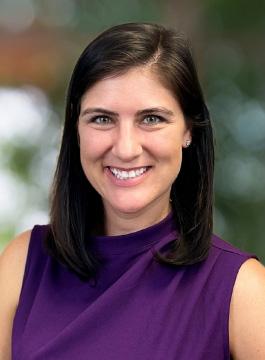
Expert Answer:
Communication is key. While you’re not required to share every detail of your plan, giving your family a general sense of your intentions can help reduce misunderstandings. Consider writing a personal letter to explain your decisions—especially if they might be perceived as unequal. Sometimes, fairness doesn’t mean equal—it means thoughtful.
It’s also important to choose the right people to handle your estate. If your children and stepchildren don’t get along, naming one of them as executor or trustee can create conflict. In these cases, a neutral third party like a professional fiduciary or trusted advisor can help keep things fair and objective.

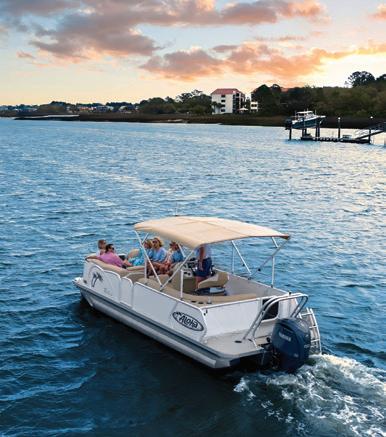









Blended families are more common than ever, and with them come unique challenges—especially when it comes to estate planning. While love may bring families together, differing expectations, loyalty to biological parents and long-standing tensions can make navigating inheritances emotionally charged. When children and stepchildren don’t get along, having a clear and thoughtful estate plan isn’t just helpful— it’s essential.
One of the biggest mistakes in blended family planning is assuming “it will all work itself out.” Without written instructions, what you leave behind can lead to confusion, resentment and even costly legal battles. This is particularly true when there are unequal distributions, or if a surviving spouse is expected to “do the right thing” after your death without any legal obligation to do so.

Start by being realistic. Acknowledge family dynamics as they are—not as you wish them to be. If tensions exist between your children and your spouse’s children, your estate plan should account for that. This may mean using tools like a trust to ensure your biological children are protected while still providing for your spouse or stepchildren. Trusts can allow you to set clear terms and avoid probate, which keeps your wishes private and less vulnerable to challenges.
Lastly, update your documents regularly. Life changes—marriages, divorces, births, deaths—all can affect your plan. Make sure beneficiary designations on retirement accounts and life insurance policies align with your wishes and the rest of your estate documents. With blended families, estate planning isn’t one-size-fits-all. It requires honest reflection, clear documentation, and the right guidance. Done well, it can help preserve family relationships—or at least prevent further strain—while ensuring your legacy is honored. A strong elder law and estate planning attorney can guide you through this making sure your wishes are clearly laid out so there is no question about your plan.
For educational purposes only. This is not legal advice. Lisa Hostetler Brown is a Certified Elder Law Attorney certified by the National Elder Law Foundation. 10 Pinckney Colony Rd, Ste 400, Bluffton, SC 29909 | 843-757-5294 | HiltonHeadElderLaw.com



By Sasha Sweeney Editor
With a ceremonial ribbon replaced by a line of carrots, The Seabrook of Hilton Head officially welcomed Restaura Hospitality Group as its new dining partner earlier this month. The event marked the company’s first full-service senior living launch and introduced a new approach to dining focused on health, local ingredients and shared ownership.
“We met the Seabrook team at a LeadingAge conference in Nashville, Tennessee.” said Joseph Cuticelli, CEO of Restaura. “They showed interest, and we had the opportunity to spend a little bit of time with them. From that point forward, the process began... which then turned into them being our first client.”
Founded by two veterans of national food service companies, Restaura emphasizes what Cuticelli called a “three-legged
stool” approach: “unapologetically delicious food,” proprietary dining technology, and employee ownership.
Prior to the carrot cutting, team members received ownership certificates from Restaura founders Cuticelli and Richard Schenkel, part of the company’s defining structure. “Everyone is an owner,” Cuticelli said. “We believe that that ownership culture... changes the way that they serve the customer.”
On food, Cuticelli said, “Everything that we do is scratch made. We are buying local products... South Carolina chicken from South Carolina, beef from South Carolina, trying to be good stewards of the community when we’re purchasing goods. We call it responsibly sourced.”
For Seabrook residents the dining experience is also being shaped by real-time feedback. “We have an incredible technology platform... with some predictive ana-
lytics and generative AI,” Cuticelli said. “We’re monitoring resident sentiment in real time.”
Customization also extends to dietary needs. “We will actually do an intake with residents... [to understand] what their limitations are relative to dietary restrictions... but also what are their preferences,” he said. “We put that information into our system... and we can make recommendations to them in advance.”
He cited a recent gumbo served at Seabrook: “It was nutritionally significantly better than any gumbo that they had ever had. It was a little less salty... and we were very intentional with that.”
Asked about early results at Seabrook, Cuticelli said it was too soon to draw conclusions. “It’s only been six weeks,” he said. “If you ask me what long-term success looks like... the Seabrook is known as a dining destination, the best senior living
dining... on Hilton Head Island.”
Reflecting on Restaura’s launch, Cuticelli emphasized the importance of staying connected to clients and communities. “One of the most rewarding things is actually getting to know the people who live there,” he said. “We never want to be that big, large company again. We want to be able to manage those relationships very intimately.”
Restaura plans to expand its model nationwide but said its roots in the Lowcountry matter. “The shrimp... that we served [at the event], that was local shrimp from South Carolina,” Cuticelli noted. The full-service transition at Seabrook includes on-site training, recipe development and continued support. For more about Restaura, visit restaura.com. Information about The Seabrook of Hilton Head is available on their website theseabrook.org.



















Mathew Epps MD, MS, DABS
Jane Epps RN, BSN


By Dr. Jean Harris Contributor
I asked a number of my friends and golf students this question and got a variety of answers. Most of them were reasons why they didn’t watch women’s golf. I will list some of these and see if you are in this category. I will also list reasons why I feel you should be watching these great athletes. Reasons why some people do not watch the LPGA on TV:
• They are playing for smaller purses. Last year Nellie Korda won 7 tournaments and won only 4.4 million dollars. The PGA pros in Majors and Signature events receive that for winning one tournament. The winner in the KPMG Major for women won 1.6 million. The winner of the PGA Traveler’s tournament the same week won 3.6 million.
• They don’t play the big-time courses like the Augusta National and the Players. I like watching golf on courses that I have heard of. The good news is the LPGA will be playing in future years Pebble Beach, Olympic Club, Erin Hills, and the Old Course at St. Andrews.
• They are usually on TV channels that cost extra to subscribe such as Peacock. I tried to find the KPMG Ladies tournament on Sunday and they were on Peacock from 11 – 3:00 and 3:00-6:00 on NBC. Conversely. The PGA tournament was on TV most of the day on ESPN, Golf Channel and CBS.
• The tour is dominated by golfers from Asia and Korea. I can’t even pronounce their names. What happened to the good old days of wom-
en’s golf with Kathy Whitworth, Nancy Lopez, Michele Wie and other American golfers I could relate to.
• The TV graphics aren’t as good as the PGA Tour. The commentators aren’t as interesting.
• Many women athletes are typically stereotyped by their appearance rather than their athletic performance. The PGA pros do not have this type of scrutiny. Reasons why you should watch the LPGA on TV:
• LPGA golf is more relatable to the amateur golfer.
• Most LPGA Tour courses are set up between 6,200 and 6,600 which compares to what most men play at their home courses. Men can definitely relate to the women’s distances compared to the PGA tour.
• The average clubhead speed for LPGA golfers is 100 mph and that is more than most amateur men at 80-90 mph.
• LPGA golfers have great tempo compared to PGA professionals.
• LPGA typically have great short games.
• The LPGA players are using equipment that the average male golfer should be using.
• LPGA will carry clubs in their golf bag, such as hybrids, that the amateur golfer will have in their bag. Most amateur golfers cannot relate to the distances the PGA golfers hit. I really hope that you will be watching the LPGA in the future.
Dr. Jean Harris is an LPGA Master Professional and teaches at local golf courses. jean.golfdoctor.harris@gmail. com; golfdoctorjean.com.


Let A meric A n Wood r efAce create your new dream kitchen in less than a week with our premium 1 /4'' S olid Wood c A binet r efAcing . Saves time and hassle, and saves up to half the cost of replacement.
Our experienced carpenters painstakingly reface the cabinet boxes with premium furniture-grade 1 ⁄4” solid hardwood
We install brand new Amish-crafted solid wood doors and drawer fronts –cabinets look and perform JUST LIKE NEW AGAIN!
“Ten stars for American Wood Reface! We had our kitchen cabinets refaced and are so pleased with the results. A top notch company from start to finish. AWR’s price for refacing was several thousand dollars LESS than a company that wanted to use formica! I can’t say enough about the professionalism and quality AWR provided.” ~ Bill R.
Huge selection of styles, colors, and wood finishes in eight different domestic woods. Beautiful new stone countertops. Modify and customize cabinets: change function, extend, reduce or add new cabinets. Roll-outs† and drawer banks for accessibility and convenience.
“American Wood Reface’s installer did an absolutely fabulous job installing the facing for a perfectly seamless appearance. The fit and finish of the new doors and drawers is just perfect and of the highest quality. My wife and I are completely thrilled with our new kitchen, and the skill, craftsmanship and professionalism of American Wood Reface’.” ~ A.L.




By Shoranda Clark Contributor
“If you can’t fly, then run. If you can’t run, then walk. If you can’t walk, then crawl. But whatever you do, keep moving forward.” – Dr. Martin Luther King Jr.
This powerful quote has helped me get through some difficult moments in my career. I’ve been a hospice-certified nursing assistant for 29 years—21 years actively working as a CNA and eight years in an administrative role, all with Friends of Caroline. In the beginning, besides a lot of crying and prayer, I came to recognize that this work is my calling. Some may find it depressing, but I find it deeply rewarding. It was especially challenging at the start of my career, particularly after losing my first patient. But, over time, I realized that my patients were giving me something as meaningful as the care I gave them.
Working with terminally ill patients helped put some perspective in my life because they shared their regrets and the things they wished they had done differently, hearing their stories helped me appreciate my own life so much more.
Through this work, I became a better mom and wife, I hug my loved ones, telling them how much I love and appreciate them. I’ve learned to live life with no regrets, and I’m truly grateful for each day God gives me.
It is a blessing to provide physical and emotional care to someone at the end of life. I once had a patient who refused to let her family bathe her. Several of my fellow CNAs tried, but she still declined. When it was my turn to visit her, we simply talked. I learned that Yahtzee was her favorite game. So, I made a deal with her: after her bed bath, we’d play a game of Yahtzee. She agreed.
That became our morning ritual—a bed bath, a cup of cappuccino, and a game of Yahtzee. Week after week, we had so much fun. As her health declined and she could no longer roll the dice, I rolled them for her. We kept playing because it brought her joy. We continued this routine until her last week. I truly believe this small gesture brought light into her life.
witness, so knowing when to take time for yourself is important. Having a healthy work-life balance is essential. Over the years, I’ve worked with some amazing CNAs who are passionate about their work.
One of my fellow CNAs once volunteered to help a patient pull weeds from her garden—not part of her job, but she did it because the patient loved her garden. When you love what you do, it’s easy to provide compassionate, handson care and emotional support, all while enhancing a patient’s quality of life.
I could tell countless stories about how extraordinary hospice CNAs are. But great patient care takes more than just individual effort—it takes a team. Our team includes a skilled medical director, nurse practitioners, nurses, a social worker, a chaplain, and volunteers. CNAs often spend the most time with the patient, and we work closely with nurses to act as a bridge between patients, families, and the care team, ensuring everyone is aligned on the patient’s needs.
It’s heartwarming when someone stops to thank you after learning you work in hospice. I believe it’s an honor to help someone cross over with dignity. If I had the chance to change anything about my career, I wouldn’t. Serving our community has been both an honor and a privilege, and I look forward to the next chapter with our amazing team at Friends of Caroline.
Shoranda Clark, Director of Human Resources for Friends of Caroline.


Not every case is like that one. Sometimes, the dying process is difficult to







Turtle Talks
Mondays (June–August) • 8–9 p.m.
Lowcountry Celebration Park, 94 Pope Ave, Hilton Head Island
Free weekly sea turtle presentation by Amber Kuehn, Director of Sea Turtle Patrol HHI. Learn about turtle biology and island conservation efforts. Held rain or shine—bring a chair or blanket. seaturtlepatrolhhi.org/eventcalendar/
Mayor’s Cup 5K and Concert
Wednesday, July 2nd • 6:30–8:30 p.m.
Oyster Factory Park, Bluffton Evening run followed by a community concert. Walkers and families welcome. Registration details at townofbluffton. sc.gov.
Town of Bluffton Independence Day
Pre-Party & Fireworks
Thursday, July 3rd • 5–9:30 p.m.
Martin Family Park, Bluffton
Live music, food trucks, and fireworks viewable from Oyster Factory and Wright Family Parks. Family friendly and free to attend.
Gregg Russell Summer Concerts
Monday–Thursday through August 7
Also Friday, July 4th • 8–9:30 p.m.
Under the Liberty Oak Tree, Harbour Town
Beloved island tradition with live music for all ages. Free and family friendly.
Fourth of July Parade
Friday, July 4th • 8:30 a.m. registration / 9:30 a.m. parade start

Harbour Town, Hilton Head Island
Decorate bikes, wagons, and pets to join this patriotic parade. Followed by carnival games on the lawn. Free; first 100 registrants get supplies.
Fourth of July Fireworks
Friday, July 4th • starts at 9 p.m.
Harbour Town, Hilton Head Island
Celebrate Independence Day with fireworks over Calibogue Sound. Live music, food, and fun throughout Harbour Town. Weather permitting.
Flight n Fancy Exhibit by Janet Urbanic
July 6th–August 2nd
SOBA Gallery, 6 Church St, Old Town
Bluffton
Featuring whimsical oil and watercolor batik art inspired by Lowcountry wildlife. Free public reception Thursday, July 10 • 3–5 p.m.
Info: sobagallery.com • 843 757 6586
DJ Alan Family Shows
Fridays, July 11th & 25th • 8–9:30 p.m.
Liberty Oak Tree, Harbour Town
Interactive games, dancing, and music for all ages.
Palm Trees & Pistons
Car Show at Nala’s
Saturday, July 12th • 9–11 a.m.
Nala’s Beach Bar & Grill Parking Lot, Hilton Head Island
Monthly car show showcasing vintage, exotic, muscle, and unique cars. Free to attend or display—bring a vehicle or

just enjoy breakfast and cars. Starts at 7 a.m. with breakfast at Nala’s. Weather permitting. NalasBeach.com
Rick Hubbard’s Great American Kids Show
Friday, July 18th • 8–9:30 p.m.
Liberty Oak Tree, Harbour Town
Family comedy, music, and fun where every child participates—ending with a kazoo finale.
Slide Out of July
Saturday, July 19th • 9 a.m.–noon
Buckwalter Place Amphitheater, Bluffton
Free waterslide fun for kids to beat the summer heat. Bring towels and sunscreen.
Lowcountry Boil Benefit
Saturday, July 19th • 4–7 p.m.
SideHustle Brewing Co. Lot, 10 Buck Island Rd, Bluffton
Traditional Frogmore Stew buffet (shrimp, sausage, corn, potatoes) at $35/platter. Includes live music and kids’ entertainment. Tickets available online through July 17. Proceeds support The Blessing Ministry’s Christmas Shop.
Details: blufftonworship.com/ lowcountry-boil/
May River Shrimp Fest Hawaiian
Shirt Sunset 5K
Thursday, July 24th • 7:30 p.m.
Oyster Factory Park on the May River,

Bluffton
A festive 5K run/walk—run in Hawaiian shirts! Includes post-race party, themed T-shirt, and lei. Open to runners and walkers; strollers and leashed pets welcome.
Register at bearfootsports.com • 843 757 8520
May River Shrimp Fest Sunset Party
Friday, July 25th • 5:30–9:30 p.m.
Oyster Factory Park on the May River, Bluffton
Sunset celebration featuring live music by “Cristaldi & Stiltner” and “Vanna & The Rump Shackers,” local seafood, craft beer & boutique wine. Family and pet friendly.
More info at blufftonsunsetparty.com • 843 757 8520
Shore Notes Summer Camp for Singers
Mondays, July 28th, August 4th, 11th, and 18th • 6–8 p.m.
Church of the Palms, 1425 Okatie Hwy (Rte 170), Okatie
Free singing camp for women 18+ hosted by Shore Notes A Cappella Chorus. Learn 4-part harmony—no music reading required. Ends with a performance on August 25th at 7:30 p.m.
www.shorenotes.com
Take and Make: Beeswax Wrap
Wednesday, July 30th
Hilton Head Branch Library
Sustainable kitchen craft—while supplies last.
By Sandro Virag Contributor
Are you one of those people who says “oh I can’t dance – I have two left feet?” You are not the only one thinking that. So many dancers have started out that way – feeling awkward or intimidated. Ballroom dancing is a skill, which means anyone can master it. With the proper instruction, anyone can learn to move with confidence and grace. All you have to do is show up.
So many people think they must be a natural or have years of experience; but in fact, ballroom dancing is designed to be taught step by step at each person’s own pace. Just be sure and bring a positive attitude and a willingness to learn. Your instructor will know how to break down moves and make them approachable and fun. It’s not about perfection, it’s about progress.
The nice thing about ballroom dance is you will start seeing results quickly. In only a few lessons, people notice better posture, more fluid movement and increased body awareness. You will learn about lead-
ing and following, staying with the rhythm of the music and connecting with a partner. Plus, you will leave each lesson with something newly learned. Feeling a sense of accomplishment after each lesson keeps you motivated and keeps you coming back.
Along with teaching footwork, ballroom dance teaches patience and how to be present in the moment. If you are stressed, dance will give you an outlet. If you are looking for a new social circle, the dance floor is full of people probably looking for the same thing. Remember the fabulous dancers you see today were once beginners.
If you are curious about dance, why wait? You probably don’t have “two left feet” and with practice you will find yourself dancing and smiling in no time.
I once read “Come as you are. Leave as a dancer” and I can’t think of anything more true when it comes to ballroom dance!
Sandro Virag is a partner and instructor at Hilton Head Ballroom Dance Studio of Hilton Head, hiltonheadballroom.com


July 22–August 22
Mon-Sat 10am-4pm, Sun 12-4pm and 90 minutes before every Arts Center performance
Opening Reception: Wed, July 23 • 5-7pm Enjoy refreshments and meet the artists • Free and open to the public

Gallery Talk/Demo: Thurs, Aug 14 • 1-3pm
Learn more about the artists and their process
SUMMER SENSATION ON SALE NOW! JUL 9–AUG 17



Summertime fun is ahead for ages 6+ with the Arts Center’s creative, action-packed summer camps! Register Online!
UPCOMING CAMPS REGISTER ONLINE artshhi.com/artseducation/camps

The “Summer” score features more than twenty classic hits including “Love to Love You Baby,” “She Works Hard for the Money,” and “Hot Stuff,” to name a few! JUL 14 – 18 | AGES 6-8 9:30AM-12PM | AGES 9-14 12:30-3PM A MUSICAL ABOUT THE QUEEN OF DISCO JUL 14 – 18 | AGES 9-14 9:30AM-12PM | AGES 6-8 12:30-3PM

Enjoy a fun and inspiring environment to explore different art forms: painting, drawing, sculpture, and mixed media. Each day features exciting projects with an art showcase on Friday! MULTI-MEDIA MADNESS

Explore music, dance, and drama while working with professional artists to create scenes and musical numbers! Then get ready to perform a mini showcase performance on Friday! PERFORMING ARTS CAMP

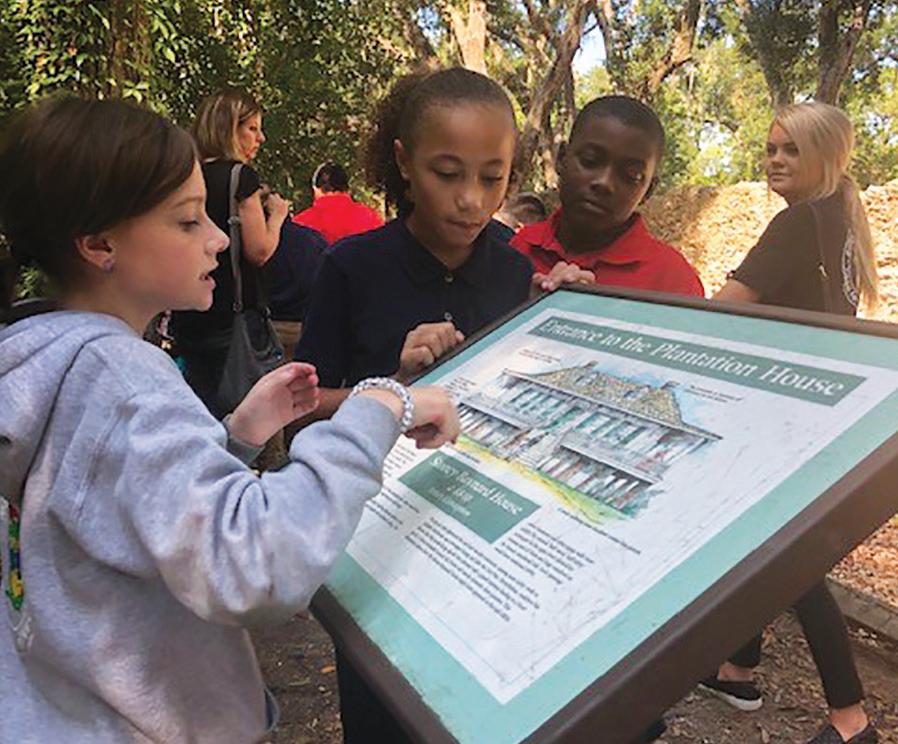

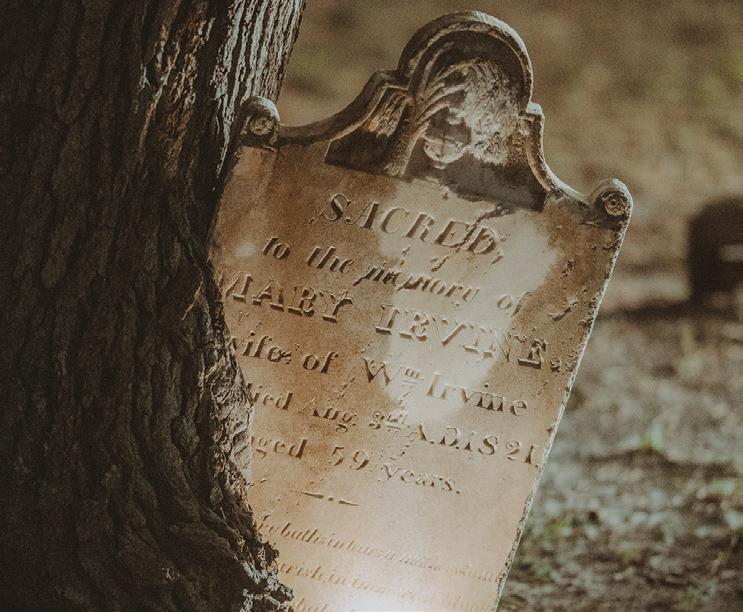

Unlock your family history with the help of our volunteer genealogists! Whether you’re just getting started or facing a research roadblock, we’re here to guide you. Call 843.686.6560 to schedule your appointment today!
We preserve and share the rich history of Hilton Head Island, stewarding two historic sites listed on the National Register of Historic Places. Throughout the year, we offer engaging classes, tours, and events, with sessions available in the spring and fall. For full details and registration, visit HeritageLib.org.
Join us as we celebrate 250 years of American independence and honor the fight for freedom! Discover Hilton Head Island’s vital role in shaping our nation’s history at HeritageLib.org – your local resource for all things related to the American Revolution
The Heritage Library is the heart of Hilton Head Island’s history and genealogy. Visit us soon!

Scan to register for classes and tours at HeritageLib.org

Independence Day on Hilton Head Island will offer a full day of activities ranging from early morning races and parades to evening concerts and two major fireworks displays.
The Firecracker 5K Run & Family Fun Walk kicks off at 8 a.m. at Jarvis Creek Park. This event, now in its 38th year, is the island’s oldest Independence Day road race and includes post-race activities for families. www.hiltonheadfirecracker5000.com
An alternative USA 5K is also scheduled to take place at Coligny Beach with proceeds benefiting the Sea Turtle Patrol. runningintheusa.com/details/11029
Patriotic spirit continues with the Sea Pines Fourth of July parade near Harbour Town. Participants can register starting at 8:30 a.m. for the 9:30 a.m. event, which welcomes decorated bikes, wagons, and pets. Post-parade games and entertainment will follow. www.seapines.com/experiences/events
At approximately 1 p.m., residents and visitors are encouraged to look skyward for the annual Salute from the Shore flyover. This tribute features military aircraft, including F-16s, a C-17, and vintage planes passing over Hilton Head’s beaches. salutefromtheshore.org
The island’s largest celebration, HarbourFest at Shelter Cove Harbour & Marina, will feature a free shuttle service to help ease access to its family-friendly entertainment and fireworks display.
Fireworks over Broad Creek will
begin after dark, following musical performances by Shannon Tanner at 6:30 and 8 p.m. and family activities including balloon animals, face painting, and interactive games with Cappy the Clown from 6 to 9 p.m. Bounce houses and train rides will be available for an additional fee.
Free parking and continuous shuttle service will be available from 5:30 to 10:30 p.m. at HHI Community Church and Sparklight parking lots near the Fresh Market at 860 William Hilton Parkway.
Visitors to Shelter Cove are reminded to use the pedestrian underpass beneath U.S. 278 if walking or biking from Palmetto Dunes. The underpass is located near the entrance to Palmetto Dunes and connects directly to the bike path. www.ShelterCoveHarbourFest.com.
In Harbour Town, another fireworks show will light up the sky over Calibogue Sound near the Harbour Town Lighthouse. Live music and food vendors will round out the evening’s festivities there, including a concert under the Liberty Oak with Gregg Russell beginning at 8 p.m. www.seapines.com/experiences/events/fourth-july-fireworks
Events are free and open to the public unless otherwise noted. Food and drink will be available for purchase, and attendees are asked to leave coolers at home. All events are weather dependent and subject to change.
Open Monday-Friday 10am -3pm
The Professional Bldg | 2 Corpus Christi | Suite 100 Hilton Head Island, SC 29928 | 843.686.6560 | HeritageLib.org


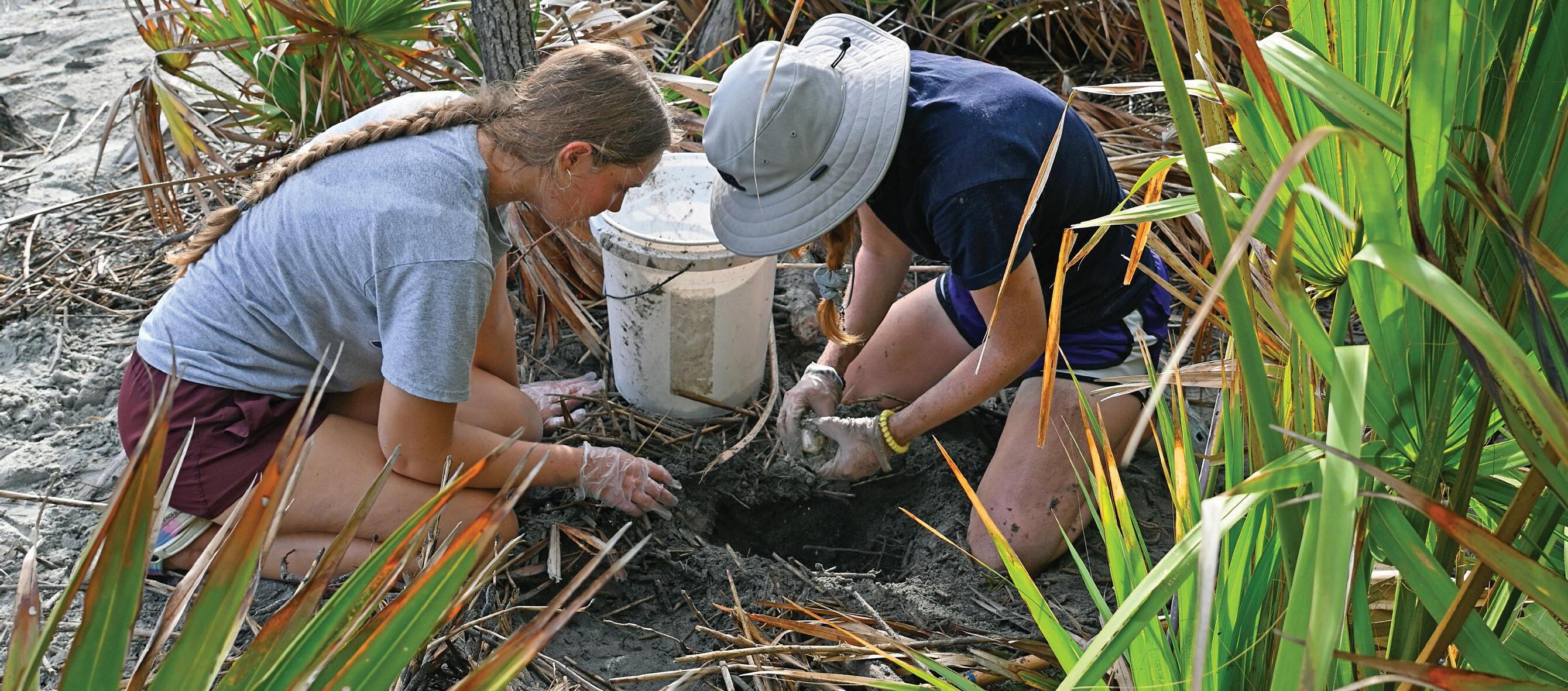



By Sasha Sweeney Editor
Keith Rushing’s new memoir, Descended: Searching for My Gullah Geechee Roots, charts his journey from family curiosity to a reconnection with his ancestral heritage on Hilton Head Island. In a recent interview, the Washington, D.C.-based former journalist reflected on the people, land and culture that helped shape his story—and the yearslong investigation behind the book.
The story begins with a name: “Sancho.” As a child, Rushing heard that name—his great-great-grandfather’s— and began asking questions. A school assignment at age 12 sparked a deeper interest in family history, and he soon found himself interviewing relatives and compiling names like Sancho Christopher and Miley Jenkins, some of the earliest ancestors he could trace.
“I always wanted to know... what was the family like?” Rushing recalled.
That interest sharpened decades later when, as a journalist attending a Black history event in Colonial Williamsburg, he mentioned to a genealogist that he had an ancestor who served in the U.S. Colored Troops. The suggestion: visit the National Archives.


Rushing followed the trail, ordering military pension files that confirmed Sancho Christopher’s service in the Civil War. “That was the name that I heard,” he said. Born enslaved on Hilton Head in 1843, Sancho later fought for the Union and returned to own land, marry, and raise a family.
Rushing’s search brought him back to Hilton Head in 2010. “I felt a sense of home... the saltwater smell, the heat, the climate,” he said. “It just felt like this is where you’re from.” His cousin Murray Christopher took him to Drayton Cemetery, where he stood at Sancho’s grave.
That visit marked a turning
point. He met with Phoebe, a cousin and retired teacher who began her career in a one-room schoolhouse, and other relatives who helped illuminate his family’s local ties. “I already had the connection,” he said of his return.
Descended blends family stories with cultural history, drawing from archival records, oral histories and local knowledge. Rushing documents the self-sufficient world of Gullah Geechee life: farming, praise houses, cast nets and communal living, often preserved in relative isolation. He pays close attention to linguistic and cultural legacies, including African-derived “basket names”—nicknames traditionally given to children based on their traits or birth circumstances, often with roots traceable to West African languages.
“These names can be a window into African identity,” Rushing said, noting that linguistic scholar Lorenzo Dow Turner traced many such names in the Gullah dialect back to specific African ethnic groups. “If families can recall these names—even if they weren’t official—it could open a path to cultural dis-

covery.”
He encourages others to begin their own explorations. Start with the elders, he said. “Ask them who they remember—grandparents, great-grandparents, what towns they lived in. Even a nickname or detail can lead somewhere.”
From there, Rushing suggests using public records, agricultural censuses, military pensions and local resources like the Heritage Library on Hilton Head. DNA analysis can also supplement oral history, particularly when traditional documents are scarce.
The memoir is personal but expansive. Rushing traces post–Civil War resilience through stories of marriage, farming, education and voting—contrasting it with the later loss of land and cultural space. Still, the legacy remains.
“These were not broken people, these are determined people,” he said. “They built their own homes, praise houses, boats, farms. They were fully self-sufficient.”
In Descended, Rushing brings back not only names, but voices, places and a culture whose memory still runs deep in the land.
Praising Rushing’s work, Emory Shaw Campbell, longtime leader at Penn Center and executive director emeritus, called Descended “an important part of the Hilton Head story” that “explains his roots in relation to African and Gullah heritage.” Elijah Heyward III, founding COO of the International African American Museum, said the memoir “employs Gullah Geechee culture as a profound lens to interrogate American identity.”
• Title: Descended: Searching for My Gullah Geechee Roots
• Author: Keith Rushing
• Publisher: University of South Carolina Press, April 15, 2025
• Price: $25.99 hardcover, 232 pages
By Sasha Sweeney Editor
The Hilton Head Symphony Orchestra has unveiled its 2025-2026 season lineup, marking its 44th year with the theme “Music for Everyone!” The upcoming season blends classical staples, jazz, pop culture tributes, and community-focused programming aimed at reaching broader audiences while honoring America’s 250th anniversary.
Music Director John Morris Russell, whose contract was recently extended through 2028, will lead many of the performances. Russell’s tenure has coincided with a notable rise in artistic reach and community impact.
Orchestra Series Highlights
The centerpiece of the season is the nine-concert Orchestra Series, which includes two performances of each program at First Presbyterian Church on Hilton Head Island.
The series opens Oct. 19-20 with cellist Christine Lamprea, a Sphinx Competition winner, performing Dvorák’s Cello Concerto. Other highlights include:
• A November program led by jazz pianist Marcus Roberts, who will reinterpret Gershwin’s Rhapsody in Blue and James P. Johnson’s Yamekraw, paired with two works by Carlos Simon.
• The return of the Holiday Pops concerts Nov. 30–Dec. 1, featuring baritone Michael Preacely and Youth Concerto Competition winner Brooklynn Thatcher.
• A February performance of Ellis Island – The Dream of America, with the Lean Ensemble Theater joining the orchestra for Peter Boyer’s dramatic tribute to immigrant stories.
• A March 8–9 concert celebrating The Music of Harry Potter, where audiences are encouraged to attend in costume for a family-friendly experience.
• The season closes April 26–27 with pi-
anist Jonathan Mamora, recent Hilton Head International Piano Competition winner, performing Brahms’ Piano Concerto No. 2.
Subscription packages are available now, with single tickets going on sale Sept. 2.
The fifth season of Jazz in the Park kicks off June 24 with six free concerts scheduled biweekly through Sept. 2 at Lowcountry Celebration Park. Performers include Tuffus Zimbabwe, Charlton Singleton Quartet, and Junior Jazz Foundation All Stars.
Outdoor pops concerts return Oct. 16-17 for Symphony Under the Stars in Bluffton and Hilton Head. A spring edition of the event is also scheduled for April 7, 2026. Competitions and Community Engagement
The Hilton Head International Piano Competition runs March 16–21, 2026, fea-
turing 20 pianists ages 13–17. Finalists will perform concerto movements with the HHSO, with the first-place winner invited back for a full concerto performance in 2026-2027.
Additional community programming includes:
• The HHSO Youth Concerto Competition (Jan. 31, 2026)
• The Gullah Geechee Cultural Series, returning in October for its fourth season, highlighting Lowcountry heritage through music, storytelling, and visual arts
At SoundWaves, the orchestra’s venue at Coligny, the Coastal Home Supper Club series offers monthly vocal performances paired with dinners from partner restaurants, featuring genres from Motown to country.
For tickets and a full schedule, visit hhso.org or call (843) 842-2055.


By Sasha Sweeney Editor
Nearly two decades after first stepping onto a Food Network set, Orchid Paulmeier is back in the national spotlight. The longtime Bluffton and Hilton Head restaurateur and owner of One Hot Mama’s is among the dozen competitors on the latest season of BBQ Brawl: Flay v. Chauhan v. Lofaso, which premiered June 1st on Food Network.
Filmed in Austin, Texas, this season pits teams of barbecue pitmasters against each other under the mentorship of celebrity chefs Bobby Flay, Maneet Chauhan and Antonia Lofaso. For Paulmeier, the show marks a return not just to national television, but to the spirit of culinary competition that first introduced her to audiences on The Next Food Network Star in 2011.
“This was probably one of the best experiences I’ve ever had,” Paulmeier said in an interview. “It was truly a cooking competition — not just about personality or presentation. How I cook and who I cooked for has completely changed. I think I just approached it in a completely different way.”
Paulmeier, who has called the Lowcountry home since the early 2000s, opened One Hot Mama’s in Bluffton in 2003 and expanded to Hilton Head in 2007. The restaurant is known for its Southern barbecue staples, including brisket, pork, ribs and wings. While she’s spent most of the past 20 years behind the pass, she’s been named a 2016 South Carolina Chef Ambassador and one of the Featured Chefs at the James Beard House Dinner. Paulmeier said the show gave her a chance to rediscover her competitive edge and remind audiences of her culinary roots.
Dubbed the “Mama Bear” of the series, Paulmeier relishes this new phase of life. “Back then, my kids were in elementary school,” she said of her first Food Network experience. “Now, they’re grown. I just moved my daughter to D.C. the same weekend the show premiered. I’m a full-

fledged empty nester mom now so definitely that comes across.”
BBQ Brawl features 12 contestants competing over 10 weeks in grilling and smoking challenges that test their speed, creativity and endurance. Unlike traditional “low and slow” barbecue, many of the episodes demand quick turnarounds — dishes completed in 30 minutes or less using live fire techniques.
Paulmeier joined Team Bobby Flay, a choice that felt like a full-circle moment. The two had previously met on Food Network Star, and she said his guidance remains just as sharp.
This season includes unique challenges, including a global grilling episode, an Argentinian Asado Iron Cross cook, and even a “Brawlers vs. Captains” showdown. The winner will be crowned “Master of ‘Cue” and receive a dedicated platform across Food Network’s digital channels.
“This season has something for everyone,” Flay said in a press release. “Wheth-
er you are a professional grill master, a weekend warrior or simply love the smokey char of barbecue done right.”
Paulmeier is no stranger to any of those audiences. A longtime advocate for outdoor cooking, she said she hopes viewers feel encouraged to get outside and grill, no matter their experience level.
“People sometimes get intimidated by live fire cooking, but they shouldn’t be,” she said. “If you’ve been eyeing a grill or smoker, go get it. The kiss of fire adds flavor you just can’t replicate in the kitchen. I’m hoping that people are inspired to grill all summer.”
While the show is clearly a competition, Paulmeier said it also became a journey centered around rediscovery.
“I’m taking the time to do this, and kind of reinvent myself and revisit the things that I haven’t done in the past. I think that’s my next journey: what’s going to happen in my second half? I hope that inspires other people to realize they don’t have to settle for what they’re doing right now.”
The experience also gave her a new sense of camaraderie. Unlike her appearance on Food Network Star, which was more individualistic, BBQ Brawl emphasizes team dynamics.
“I am a total team player. I love the camaraderie. You’re with these people, cooking side-by-side, and we all love to barbecue and grill. It doesn’t get better than that.” said Paulmierer “We have a great group chat going, so we’re all still in touch with each other”
The show’s challenges weren’t always traditional barbecue. “This was not low and slow type of competition, it was hot and fast. We got 30 minutes to cook something, so it was different in that sense, but the different flavor profiles were indications of where people are from and what their influences were.”
She’s also got a few tips for home cooks trying to up their barbecue game.
“A lot of people make the mistake of putting sauce on too early,” she said. “I always suggest to wait. Don’t be tempted to put barbecue sauce on at the start and begin cooking with it. Especially with live fire, you have to wait for the last 4 to 5 minutes to put any sauce on otherwise it’s going to burn. You always want to add it and let it just caramelize at the end.”
While Paulmeier won’t share any spoilers — “never,” she said with a laugh — she is looking forward to the rest of the season and what comes next.
“I was watching it for the first time along with everyone else,” she said. “That’s the fun part — seeing how it all came together. I’m excited for all of y’all to stay tuned this summer.”
For now, fans can follow Paulmeier’s journey on BBQ Brawl every Sunday at 9 p.m. on Food Network or stream episodes the next day on Max. Updates are also available through the Food Network website and social platforms using the hashtag #BBQBrawl.
Whether she takes home the title or not, Paulmeier has our vote.
By Sasha Sweeney Editor
The Town of Bluffton will celebrate Independence Day with a two-day lineup of events on July 2nd and 3rd, including a 5K race, live music, family activities, and a fireworks show over the May River.
Now in its fourth year, the town-sponsored festivities begin Wednesday, July 2nd, with the second annual Bluffton Independence Day 5K at Oyster Factory Park. The race steps off at 7 p.m. and benefits the Mayor’s “Stay Safe, Bluffton!” initiative, which funds student scholarships promoting safe driving.
The event is open to all ages and welcomes strollers and leashed dogs. The top three canine finishers will win prizes, and the first 400 registrants will receive a commemorative race T-shirt. Winners will be awarded the “Mayor’s Cup,” with their names engraved and displayed at Town Hall.
Live music from Deas-Guyz, a popular Lowcountry band known for its blend of Motown and beach music, will accompany the race and continue until 8:30 p.m. Food, beer, and wine will be available for purchase.
Runners and spectators must park at M.C. Riley Elementary School and use the free Palmetto Breeze shuttle to access Oyster Factory Park. Paid parking is also available at First Zion Missionary Baptist Church and Campbell Chapel AME Church, with proceeds benefiting church programs.
The celebration continues Thursday, July 3rd, with a pre-party at Martin Family and DuBois Parks from 5 to 9 p.m. The evening will feature carnival-style games, bounce houses, a rock climbing wall, and food vendors. DJ Jeff “T-Bone” Taylor will emcee the festivities, with live music from the Marine Corps Parris Island “Dirty Boots” Brass Band scheduled from 6 to 7 p.m. A local teenager will perform the national anthem on electric guitar at 5:55 p.m.
The day concludes with a 20-minute fireworks display beginning at 9 p.m. The show will launch from a barge in the May River and can be viewed from
Oyster Factory and Wright Family Parks. Due to potential changes in barge positioning, attendees are advised to adjust their seating for optimal viewing.
To accommodate the crowds, road closures around Calhoun, Green, Lawrence, Bridge, and Water streets will go into effect starting Wednesday evening and again at 4 p.m. Thursday. Homeowners will have limited access during the event, and police officers will be stationed at key intersections to assist with traffic flow.
Both the Calhoun Street Regional Dock and the Oyster Factory Dock will be closed to pedestrian traffic from 5 to 11 p.m. on July 3rd due to safety concerns. Boaters will still be able to access the docks.
Handicapped parking will be available at Town Hall, with free golf cart transportation for attendees with mobility needs.
Town officials remind residents and visitors that personal fireworks are prohibited within Bluffton limits and will be confiscated. The events will proceed rain or shine, unless canceled for safety reasons.
For more information or to register for the 5K, visit runsignup.com.













By Sasha Sweeney Editor
Each Wednesday evening during the summer, volunteers gather at the “Big Blue Chair” outside the Beach House Hilton Head Island with a shared goal: to “Put the Beach to Bed.” The hourlong program, held from 7 to 8 p.m., helps ensure Hilton Head’s beaches are safe for nesting loggerhead sea turtles.
A mix of locals and visitors—children, teens and seniors alike—take part in the initiative, a partnership between Beach House Hilton Head and Sea Turtle Patrol Hilton Head Island. Participants enjoy a short talk about sea turtles and their nesting habits before receiving gloves and a mesh bag. They then head to the beach to fill holes, knock down sandcastles and remove debris to clear the way for nesting turtles and hatchlings.
“This is our way of supporting our environment and our community—one wave, one guest and one good deed at a time,” said Cole Patterson, the Tiki Hut manager and Beach House’s Turtle Ambassador, who plays a key role in the resort’s family-friendly sustainability initiative.
Patterson works alongside Sea Turtle Patrol volunteers to educate guests and locals alike. On a recent Wednesday, Sea Turtle Patrol volunteer Cindy Green began the evening with a talk on loggerhead nesting behavior.
“We put the beach to bed to make it safe for turtles,” Green said. “If a mother comes out to lay eggs and something causes her to turn around, she will drop the eggs in the ocean. When a turtle comes ashore, she is in labor.”
She explained that sea turtles often return to the same beach where they were born—a ritual that has continued for roughly 80 million years – making them Hilton Head Island’s first visitors. Green shared photos of what turtle tracks look like as well as how to identify a nest and fun facts like the phrase “Hot chicks - cool dudes.” In sea turtles, the sex of the hatchling is determined by the temperature of the sand during incubation, not by chromosomes. Warmer temperatures gen-


erally produce female turtles, while cooler temperatures generally produce male turtles.
Loggerhead turtles nest from May through October, with each nest incubating for six to eight weeks. As of June 11, 103 nests had been recorded—more than
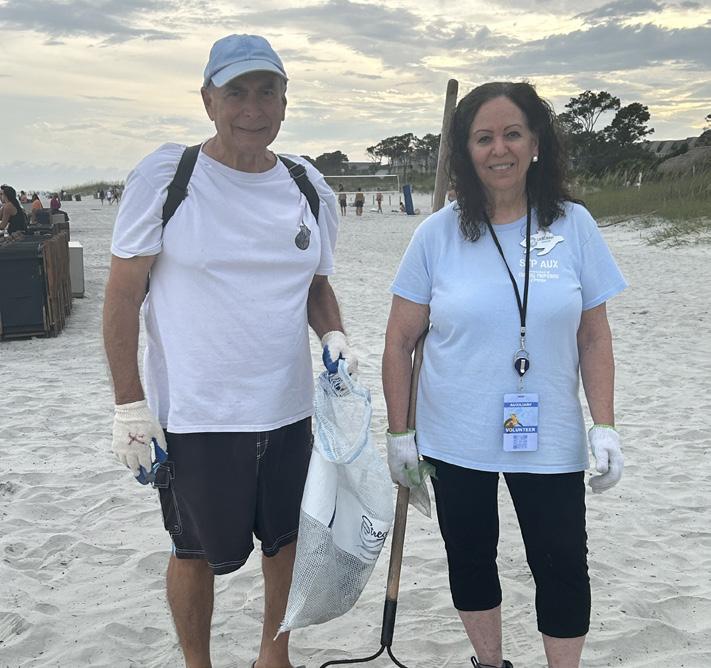
half of the 204 total nests documented in 2024. The island averages about 325 nests annually, with a record 463 in 2019. The Sea Turtle Patrol’s 24 core members are supported by a 50-member auxiliary.
“Put the Beach to Bed” volunteers follow simple but important guidelines: stay
off dunes, remove items left behind and fill in holes or dismantle structures that could block or trap turtles. Common finds include cigarette butts, bottle caps, wrappers and toys. One volunteer mentioned someone once discovered a set of dentures; another recalled his daughter finding a wallet with $400, which was later returned to its owner.
Sea Turtle Patrol volunteers assist throughout the evening, often carrying rakes to help with the cleanup and answer questions. Longtime island residents Cosimo and Deborah Urato, married 51 years, participate regularly and say the program strengthens their connection to the island.
Green said the island’s sea turtle population is a key indicator of its environmental health. “Sea turtles reflect the health of our island and the environment,” she said.
The Beach House was recently named a Certified Sea Turtle-Friendly Resort by Sea Turtle Patrol HHI. The certification requires the resort to meet specific environmental standards, including offering turtle-related activities, turning off beach-facing lights from 10 p.m. to 5 a.m., providing a water bottle filling station and distributing red flashlights for night walks. Other area hotels are adopting similar turtle-safe practices, such as replacing plastic straws with biodegradable agave alternatives.
After the beach sweep, volunteers are invited to enjoy a complimentary specialty cocktail or mocktail and live music at the Tiki Hut—the island’s only on-thebeach live music venue.
“Put the Beach to Bed” continues weekly through August 27. Organizers hope the program deepens public understanding of the fragile but vital role sea turtles play in Hilton Head’s ecosystem.
For more information or to sign up, visit www.beachhousehhi.com/beachhouse-gives-back or contact Sea Turtle Patrol Hilton Head Island at www.seaturtlepatrolhhi.org.
By Sasha Sweeney Editor
Mary J. Nestor, a Hilton Head Island author and communications consultant, has released her debut psychological thriller, Bus No. 7, through Bold Story Press. Published June 24, the 448-page novel is now available online and through major distributors.
Set in the fictional town of Shepherdsville, the book opens with a drug addict’s plan to rob a pregnant woman and escalates into a high-stakes ride aboard a runaway bus. Characters tangled in addiction, deception, and desperation collide in a suspense-driven plot exploring survival and morality.
Nestor said the idea came unexpectedly. “It started as a short story exercise at a writers conference in Michigan,” she said. “I picked a pregnant woman, a drug addict, a bus stop—and it just took off from there.”
The short story sparked immediate in-
terest. “I stood up to read it at the open mic, and people’s mouths just dropped open,” she recalled. “They asked, ‘What happens next?’ I didn’t know, but I knew I had to find out.”
The novel was a finalist in the Novel-in-Progress category of the 2020 William Faulkner Literary Competition and was picked up for publication in 2023. Nestor worked with Bold Story Press, a boutique publisher known for supporting women authors. “The editing process was intense,” she said. “I had to learn to take criticism—every page came back marked up. But they believed in my story, and that made me push through.”
Nestor’s previous books include Emily’s Best Birthday Party Ever!—a children’s story inspired by her grandchildren—and Say It Now! Say It Right!, a communications guide that draws on her experience as a speaker and HR consultant. She believes her background in communication helped shape the nuanced dialogue in Bus No. 7.
“These characters are flawed,” Nestor said. “But I think that’s what makes them real. We all carry something. That’s the humanity I wanted to bring to the page.”
Early response to the novel has been enthusiastic “Mary Nestor’s debut novel introduces a collection of unsavory and dangerous characters that sweep the reader into a dark landscape of crime and addiction where even the savvy detective has to play catch-up. Bus No. 7 has readers wondering—what awaits when they turn the next page?”—Karen Dove Barr, author of Burnt Pot Island and the forthcoming Night’s a Shadow, Day’s a Shine
The author now lives full-time on Hilton Head Island, where she is already working on the sequel. “It starts exactly where Bus No. 7 leaves off,” she said. “Some familiar faces return—and some don’t.”

Bus No. 7 is available in paperback and hardcover. ISBNs: 978-1954805859 and 1954805853. To learn more, visit maryjnestor.com or follow @maryjnestor on social media.
Nestor will host a signing at Barnes & Noble in Savannah on Aug. 2, with additional events planned on Hilton Head later this year.
Kids ages 6-14 pay



Are you a singer looking for a fun summer activity?
If so, the Shore Notes A Cappella Chorus is hosting a ‘Summer Camp’ on four Mondays: July 28, August 4, August 11 and August 18 from 6:00 to 8:00 pm, and ending with a performance on August 25 at 7:30 pm! We welcome women 18 and older (mothers and daughters too!). Carpools are available from both Hilton Head Island and Beaufort. No need to read music. You will learn how to sing 4-part, acappella harmony with our chorus!


By Leslie Rohland Contributor
Any day is the perfect time to fire up the grill and make something that’s just as bold and unexpected.

Enter: Charcoal-grilled corn with honeyed goat cheese. This is not your average backyard corn. With smoky charred kernels, a creamy goat cheese spread kissed with honey and lime zest, and a sprinkle of fresh basil—it’s summer on a cob. Sweet, tangy, savory, and just a little fancy, it’s the side dish that steals the show. Serve it alongside grilled steaks, burgers, or even as the star of a meatless meal. It’s easy to prep, fast to grill, and guaranteed to impress— even if Dad usually claims the grill as his kingdom. One bite, and he’ll gladly hand over the tongs. Just don’t forget the napkins—this one’s meant to get a little messy.
• 1(4-ounce) log plain creamy goat cheese, at room temperature
• 3tablespoons unsalted or salted butter, at room temperature
• 1½ to 2 tablespoons honey, depending of the sweetness of your corn
• 2 small limes
• 4 ears of corn, silk and husks removed
• 4 basil leaves, chopped or torn
1. Prepare the coals of a charcoal grill. (Alternatively, you can use a gas or electric grill set to the highest temperature.)
2. As the grill heats, in a small bowl, smash the goat cheese into a paste with the back of a fork. Add the butter, honey and harissa, and whisk until smooth.
3. Using a rasp grater (such as a Microplane), zest the limes and add to the mixture. Cut the limes into halves or wedges, and pile them on a large serving platter, along with the bowl of goat cheese spread. Set aside.
4. Once most of the coals are covered in

ash and the fire has subsided (or once your gas or electric grill is at temperature), add the shucked corn, completely dry, over the grates, directly above the heat. Cover the grill to trap the heat and smoke while making sure there is still airflow, and cook the corn, turning the cobs over every few minutes so they cook evenly, until the kernels go from a pale to vibrant yellow and char nicely in spots, 8 to 12 minutes.
5. Remove the cobs from the heat while the kernels are still plump and juicy,
being sure not to overcook, and arrange them on the serving platter. While corn is still warm, use a pastry brush to brush liberally with the goat cheese mixture. Squeeze the lime wedges all over the corn to cut through the sweetness and sprinkle over the basil before serving.
Leslie Rohland is the owner of The Cottage Café and Bakery, The Juice Hive and the Bluffton Pasta Shoppe. Leslie was named one of the South Carolina Chef Ambassadors for 2024.
The Italian American Club of Hilton Head awarded $2,000 scholarships to nine area high school students during a ceremony held May 1st, 2025, recognizing academic achievement and community involvement.
This year’s scholarship recipients are Connor Wiendl, Jack Boatwright, Bryce Broome, Brody Doyle, Ronnie Harvey, Isabella Perez, Olivia Perry, Connor Sheeran, and Angela Torres. All recipients are high school seniors from Hilton Head, Bluffton, and Hardeeville who reside south of the Broad River.
According to the club, the scholarships are awarded annually based on academic performance, extracurricular activities, and other criteria detailed in the club’s scholarship application. The awards are provided for one year to assist students in pursuing post-secondary education. The scholarship program is part of the Italian American Club of Hilton Head’s broader commitment to supporting education and community service. More information, including application details, is available at www.iachh. org.

By Danie Connolly Contributor

A unique summer art exhibition celebrating the often-unseen heroes of the food industry will take place Sunday, July 14th, from 4 to 7 p.m. at the Restaurant Equipment Company of Bluffton, located at 1 Sherington Drive.
Titled The Back of the House, the one-night-only show features artwork by South Carolina artists who spent the past six months documenting life behind the kitchen door — including dishwashers, line cooks, pastry chefs, food truck operators, and others whose work typically goes unnoticed by diners.
The exhibition is free and open to the public. Guests will enjoy live music by South Carolina bluegrass band Flatt Silly, complimentary refreshments, and the chance to view paintings, drawings and photographs portraying commercial kitchen life. Art will be presented in a range of media, including oil, acrylic, pastels, pen and ink and photography.


The idea to host the exhibit at Restaurant Equipment Company of Bluffton (RECOB) came after an artist approached the business with a proposal to showcase artwork depicting culinary professionals using equipment sold in the store.
“Was it a hard sell? Nope,” Danie Connolly recalled. “Once I explained that the exhibition could introduce a new audience to RECOB by having a talented group of South Carolina artists depicting the everyday life working with the exact equipment RECOB sells... [they] were in.”
RECOB opened in Bluffton 15 months ago when five longtime salespeople from Restaurant Equipment Company of Savannah — William Chavis, Carlton Parker, Lonnie Harley, David Dougle and Jeff Carey — purchased the business from its founder and relocated operations to a larger 14,000-square-foot facility. They were joined by Cynthia Cravey, who has remained a key part of the company’s customer-focused approach.
The event is intended as a tribute to the people who “create the magic” in kitchens and food service operations — from fine dining restaurants to food trucks and school cafeterias.
For more information, contact danie.connolly@yahoo. com.












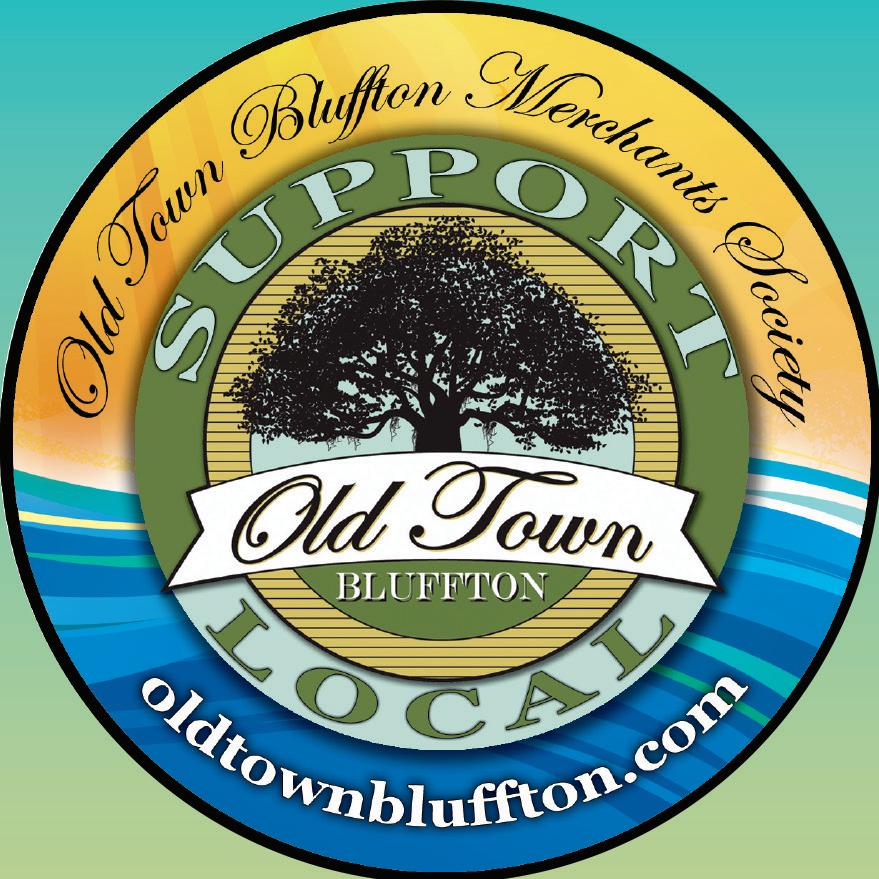


















By Thomas Dowling Contributor

In today’s uncertain world, many successful families are turning to stress testing to ensure their wealth plans are up to the task. Once used primarily by ultra-wealthy families, stress testing has become a valuable tool for individuals and families at a range of wealth levels who want confidence in their financial future.
At its core, stress testing is a formal process that evaluates a wealth plan, or parts of it, under various scenarios to determine whether the plan will still meet the family’s goals. These scenarios might include market downturns, tax law changes, unexpected expenses, or windfalls. The idea is to uncover any weaknesses or blind spots before they become real problems.
Beyond revealing vulnerabilities, stress testing can also highlight overlooked opportunities. By assessing what’s already in place and comparing it to alternatives, families can make small adjustments that may significantly improve outcomes.
A major benefit is seeing how well all your financial pieces work together. Many families work with multiple professionals, accountants, attorneys, investment advisors, who may not always coordinate. That can lead to inefficiencies or even conflicting strategies. A thorough stress test takes a comprehensive view and identifies ways to better align all the moving parts.
Originally adopted by the “Super Rich,” those with $500 million or more in net worth, stress testing has expanded to serve a wider group. As more advanced financial tools become available to affluent but not ul-
tra-wealthy families, the popularity of stress testing continues to grow.
But with that growth comes a downside: not all stress tests are created equal. Some advisors offer a watered-down version of the process or treat it as a sales tactic to push new products. That’s not what stress testing should be.
To ensure your stress test delivers real value, here are three key steps:
1. Work with someone who can clearly explain the process.
A good advisor should help you understand why stress testing matters and that the goal isn’t necessarily to change your plan, but to confirm it’s strong or make minor improvements. Think of it like a financial physical: you may feel fine, but it’s worth checking under the hood to catch issues early or find ways to perform even better.
2. Choose someone who sees the human side of wealth.
Your wealth plan shouldn’t just look good on paper, it should reflect your values, goals, and priorities. The best stress tests consider not just performance metrics but how your plan supports what matters most to you.
3. Find a technically skilled professional.
Your advisor must be capable of understanding complex financial structures and comparing them against possible alternatives. That includes evaluating legal, tax, and investment strategies thoroughly and responsibly.
When done right, a stress test can reveal hidden risks, uncover missed opportunities, and help ensure that your wealth plan is truly working for you and not just on autopilot. For families who want peace of mind and clarity, it’s a smart step forward.
Thomas M. Dowling, CFA, CFP®, CIMA® is the Head of Wealth Management at Alliance Global Partners of the Lowcountry on Hilton Head. He can be reached at infohh@allianceg.com or (843) 420-1993.

By Sasha Sweeney Editor
A new AI-powered medical translation platform created by a longtime Hilton Head surgeon aims to solve one of American healthcare’s biggest problems: patients not understanding their own medical records.
Dr. Chris Wixon, a vascular surgeon who has practiced in the Lowcountry for more than two decades, launched RosettaMD on June 18th. The free, ad-free tool allows users to paste or upload medical documents—such as CT scans, lab reports or discharge summaries—and receive immediate, plain-English explanations.
buying
“There’s no reason a patient should feel panic reading their own chart,” Wixon said. “RosettaMD is about replacing fear with clarity. That starts with language people actually understand.”
The platform requires no login, collects no data, and operates without ads or upsells. Wixon, who founded Bluffton-based ArchimedesMedical to build the app, said the idea came from personal experience.
“My brother had a cancer scare,” Wixon said. “He read his CT report and assumed the worst. It turned out to be a common, harmless finding—but that moment stuck with me. I realized how often this happens in my own practice.”
RosettaMD has already translated more than 15,000 real-world medical documents and is being used by cancer patients preparing for second opinions, parents managing pediatric diagnoses, seniors navigating imaging results and caregivers coordinating care.

Dr. Chris Wixon



Unlike symptom-checkers or chatbots, the platform uses physician-trained, deterministic AI that produces the same trusted output every time. The underlying engine was built using more than half a million medical language patterns and plain-English interpretations.
Wixon said he chose to stay in the Lowcountry—not Silicon Valley—be-

cause this is where the need was most visible. “In Hilton Head and Bluffton, patients walk in with folders full of records they don’t understand,” he said.
“This tool is for them.”
RosettaMD is available at rosettamd. com. It is free to use and does not store or transmit data.
“This isn’t about replacing doctors,” Wixon said. “It’s about making sure people understand what their doctors write. That understanding is what leads to better outcomes—and peace of mind.”
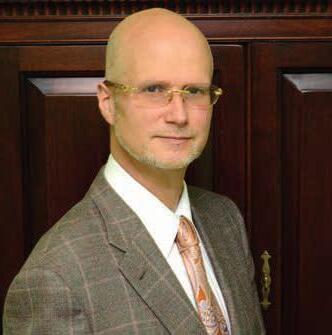

Pure Med Spa is here to assist you in achieving your skincare goals.

“At Pinnacle, we want our patients to feel like they are part of our family and we strive to treat them that way from the first time they visit. We pride ourselves on the customer experience. It is important to always keep up with the latest advances, but our practice uniquely separates the gimmicks from the options that produce results. It is our philosophy to listen first to our patients’ goals and then help guide them to the treatments and procedures that will help us all work toward that shared goal. Your inner and outer you should be in harmony.” Fine Lines | Wrinkles | Elasticity | Firmness Even Tone | Vibrancy | Skin texture Enlarged Pores | Oily or Congested skin





By Abby Bird aka Alphadog Contributor
When I meet readers of my articles in the community, they often ask about my dogs and their history. I currently have four, ranging in age from 4 to nearly 9.
The oldest is Finn, an almost 9-yearold Cavalier King Charles Spaniel. I adopted him at 1½ from a home where he was constantly attacked by a male Corgi. He was miserable and afraid. The owner asked if I would take him in. I’m not usually a small-dog person, but Cavaliers are my favorite small breed—so I (sigh) said yes.
The transformation was complete. Finn went from being a beaten, submissive pup to the top dog in my pack. He walked in, looked around, and seemed to decide: no male dogs here, so I guess I’m in charge. Not what I expected. He’s a 23-pound alpha who still dislikes male dogs. Thankfully, he’s also very affectionate and now serves as a Hos-Pets therapy dog. He loves visiting assisted living and hospice facilities and soaks up attention from anyone willing.
Gidget is about 7½, a brown and white Newfoundland. She was purchased at an Amish farm auction at age 3 to be bred. That didn’t work out—thankfully—and she was listed on Petfinder. I drove to Atlanta and came home with her. After spaying her, she joined the pack.
Gidget has a high prey drive—small animals, lizards, even insects aren’t safe. She’s afraid of the dark and thunder, likely from spending her early years in a barn. She’s only mildly affectionate and
has little interest in pleasing humans but loves other dogs. Occasionally, she’ll deign to offer a kiss or ask for attention. Grizzly Bear came to me at 1½, a Newfie-Doodle rescued through RescueMe.org in Florida. His original owners gave him up because he got “too big.” (Really—what did they expect from a Newfoundland-Poodle mix?) At 121 pounds, he became mine. Now almost 4 and 135 pounds, he’s the sweetest goofball I’ve ever met. His nickname is Dufus. He’s affectionate but not the brightest dog I’ve owned. He has no sense of personal space and loves swimming and snuggles.
The newest addition is Jade, a 3-yearold purebred brown Newfoundland. She was put up for adoption because she wasn’t considered breedable due to bilateral hip dysplasia. She’s sweet as sugar, another dog with no understanding of personal space, and proudly identifies as a Velcro dog. She recently became a therapy dog and loves visiting assisted living and memory care residents—and children. She’s also my most expensive: she requires medications, supplements and alternative therapies to stay comfortable.
These four-legged fur balls let me share their home. They drain my credit cards and bank account. Their food, pills and accessories take up a room of their own. They leave fur, toys, chew bones and slobber everywhere.
I wouldn’t change a thing.
Abby Bird is the owner of Alphadog Training Academy. AlphadogTrainingAcademy@gmail.com
By Alex Barry Contributor

For many Americans, July 4th is a day of celebration—filled with fireworks, family, and festivites. But for combat veterans and others living with post-traumatic stress disorder (PTSD), the explosive sounds can trigger intense emotional and physical reactions. The sudden booms and flashes may evoke memories of combat or traumatic events, leading to anxiety, flashbacks, or panic attacks. With some thoughtful planning and community awareness, it’s possible to make Independence Day more inclusive and manageable for those affected.
1. Prepare in advance Veterans should be encouraged to cre-
ate a personal coping plan. This might include using noise-canceling headphones, creating a calming environment in a windowless room, or taking a trip to a quieter area during peak fireworks hours. Practicing grounding techniques—such as deep breathing or engaging in mindful distractions—can provide a buffer against distressing stimuli.
2. Open communication
Veterans living with PTSD can benefit from letting neighbors and friends know about their condition in advance. A simple conversation or neighborhood note can go a long way in fostering understanding and potentially minimizing nearby fireworks activity. For those in supportive relationships, discussing the day’s and agreeing on a plan for comfort and safety can be empowering.
3. Utilize support resources
Mental health organizations, including the VA and local veterans’ centers, often offer toolkits or hotlines around triggering holidays. Veterans should know that
they are not alone. In addition to professional support, online communities or peer support groups can offer encouragement from others who’ve navigated similar challenges.
4. Encourage firework-free zones
Communities can play a crucial role by establishing designated firework-free areas or setting limits on when and where fireworks can be set off. Public awareness campaigns that highlight how fireworks affect PTSD sufferers can lead to more considerate celebration practices over time.
5. Practice compassionate celebration
The joy of Independence Day doesn’t have to come at the expense of others’ well-being. Families can opt for alternatives—like sparklers or light shows—to keep the spirit of celebration while reducing harm. Small gestures of empathy and understanding can have a lasting impact. Ultimately, July 4th is about honoring freedom—including the freedom for all to
feel safe in their own neighborhoods. With compassion, communication, and preparation, we can make that promise a reality for veterans and others with PTSD.
Alex Barry, MA, LPC-A. is the acting Executive Director of Mental Health America of the Lowcountry, providing daily adult group mental health counseling programs in Bluffton and Beaufort for clients with schizophrenia, bipolar disorder, depression, anxiety, PTSD and more.

By Chip Collins Contributor

In the world of real estate, most buyers and sellers focus on price, inspections, and closing dates. But one of the most common, and least discussed, pitfalls in a home sale involves something far more personal: furniture, fixtures, and contents. These items can become major sticking points late in the transaction if not addressed clearly and early on.
Here in the Lowcountry, where vacation homes and investment properties are prevalent, the issue is particularly common. Many homes are sold fully furnished, especially villas that are used as short-term rentals. In those cases, it’s often expected that everything stays -
from silverware to sofas to bikes and beach gear. Why? Because future bookings often rely on those items being in place, and pricing usually reflects a “turnkey” package.
Problems arise when expectations aren’t clearly communicated. For example, if a buyer assumes everything is transferring with the house but a seller wants to negotiate out the furniture cost, or vice versa, the result can be confusion or frustration at best - or a failed deal at worst.
That’s why it’s so important to be specific. Sellers should take the time to create a “Not Included in Sale” list ahead of listing the home. This list should call out any heirloom furniture, sentimental items, or personal artwork that won’t be staying. Ideally, those items should either be labeled clearly or removed from the home before showings begin. Even if the buyer sees a list, if they fall in love with a painting hanging on the wall, they might still try to negotiate for it—so eliminating temptation can be a smart move.
Another helpful tip: put this list togeth-

20 Canvasback Road, Sea Pines. Listed for $3,495,000 furnished by Collins Group Realty.
er while you’re actually at the property. Especially for owners who live out of town or use the home seasonally, it’s much easier to remember and document everything in person rather than trying to recall details remotely when a contract is




being negotiated.
Some sellers may be downsizing or moving far away and willing to part with certain pieces. In those situations, a simple line in the listing such as “furnishings negotiable” can invite a conversation without complicating the deal itself. If the buyer is interested, a separate bill of sale can be drafted outlining the agreed-upon items and value. This bill of sale should be tied to the real estate contract—but handled separately to keep things clean. Why is separation important? For one, lenders won’t finance personal property like furniture. They’re only interested in the value of the real estate itself. That means any furnishings need to be valued and transferred outside of the mortgage. Appraisers follow the same logic. If a property sells for $800,000 and includes $50,000 worth of furnishings, the appraiser will likely remove that $50,000 from the valuation of the home to reflect the true real estate value.
Experience affordable golf on the Island with the only par-3 course–perfect for instruction, children, and senior play. Driving range and putting green are open to everyone. $10 donation for adults, $5 donation for kids – all you can play. You don’t need to bring clubs – the pros at the First Tee will lend you a set at no charge!
FROM PAGE 48A
Sometimes, sellers and buyers will even agree to attribute little or no value to the furniture—particularly if it’s dated or inconvenient to move. In that case, the furniture becomes more of a convenience factor than a financial one, and a bill of sale for $1 might be drawn up just to document the arrangement.
Another area of confusion can be appliances and wall-mounted TVs. In this market, appliances like refrigerators, washers, and dryers typically stay, though that’s not always the norm in
other regions. Mounted TVs, while technically considered personal property, are often expected to remain tooespecially when removing them involves patching holes and repainting. Sellers are encouraged to include these in the sale when possible, to keep things simple. At the end of the day, smooth transactions come down to preparation. The earlier sellers (and buyers) think through.
Chip Collins is the Broker-Owner of Collins Group Realty founded in 2002. Find Chip at chip@collinsgrouprealty.com or collinsgrouprealty.com
By Emma June Grosskopf Contributor
Beaufort Memorial is expanding access to cardiovascular care in the Lowcountry, welcoming a board-certified nurse practitioner with more than 20 years of experience and launching new screening services on Hilton Head Island.
Beaufort Memorial Heart Specialists has added Nicole Gray, MSN, FNP-C, AGACNP-BC, to its team. Gray, a Navy veteran and board-certified nurse practitioner, brings decades of experience in both acute and chronic cardiovascular care. She will see patients in Beaufort, Okatie and the main hospital.
“Ms. Gray and her extensive background in acute care will be a valuable addition to our team of cardiology specialists,” said Beaufort Memorial President and CEO Russell Baxley. “Her skill in connecting with patients and experience delivering compassionate, patient-centered care will benefit patients throughout the Lowcountry.”
Originally from Buffalo, N.Y., Gray has worked in trauma care, forensic nursing, cardiology and administrative leadership. In 2023, she founded a heart failure clinic while working for the Department of Veterans Affairs in New York. She also served as a clinical instructor and public speaker on cardiovascular health.
“I treat all of my patients like they are members of my family,” Gray said. “Having a sense of humor is key; I like to make them laugh and put them at ease.”
Gray joins a care team that includes board-certified cardiologists Drs. Francis O’Neill, Stephen Fedec and Stuart Smalheiser, as well as physician assistant Tara Kay.
Beaufort Memorial Heart Specialists has offices in Okatie at 122 Okatie Center Blvd. North, Suite 300, and in Beaufort at 300 Midtown Drive.
In a further investment in regional heart care, in June the nonprofit health system began offering low-cost vascular screenings at its Island Imaging facility on Hilton Head, joining its existing locations in Beaufort and Okatie.
The screening, which costs $60 and is not covered by insurance, includes three evaluations: a carotid artery scan, an abdominal aortic aneurysm scan and an ankle-brachial index scan.
“If you are 50 or older and have cardiovascular disease risk factors, you should be screened,” said Dr. Francis O’Neill, an interventional cardiologist at Beaufort Memorial Heart Specialists. “These risk factors include obesity, high blood pressure, smoking, diabetes or a family history of cardiac or vascular disease.”
The screening is designed to identify stroke risk and detect conditions like peripheral vascular disease, aortic aneurysms and plaque buildup in the carotid arteries. To schedule a screening in Hilton Head, Beaufort or Okatie, patients can call 843-522-5635.
To schedule an appointment with Gray or any of Beaufort Memorial’s cardiovascular providers, call 843-770-4550.










Bluffton Post Office Job Fair
Beaufort/Burton Post Office Job Fair
Hilton Head Post Office Job Fair
Hardeeville Post Office Job Fair
Ridgeland Post Office Job Fair
St. Helena Island Post Office Job Fair
THURSDAY, JULY 29th, 2025
Located at the Bluffton Post Office at 25 Thurmond Way, Bluffton SC 29910
ASSISTANT RURAL CARRIERS (Sun/Holidays) RURAL CARRIER ASSOCIATES (Relief Carrier) Apply for all SC Post Offices
US Postal Service Postmasters will be on hand to answer your questions about careers with the USPS!
Visit www.usps.com/careers to complete an application.
Online assessments can now be completed from your electronic devices.
Post Office Job
• Must have a valid SC Driver’s License
• Must be at least 18 years of age
13th,2022 10:00 AM - 2:00 PM





• May be required to use your personal owned vehicle ($0.97 cents per mile)
• PAY: $20.38 per hour paid Bi-Weekly; There is NEVER a charge for background checks, to apply or test. If you are ‘charged’ you have been re-directed to a third-party site. Visit usps.com/careers to apply for a career with the US Postal Service.
By Dr. Cassandra Beard Contributor

And the Heat Goes On
The heat of summer is going strong here in the Lowcountry! With more people spending more and more time outdoors, there also comes an increased risk for sunburns. Those unplanned extended outings when you didn’t use adequate sun protection, or the false confidence of a cloudy day can leave you unsuspectingly susceptible to a dangerous sunburn. And while many people may consider a suntan to be attractive, an actual sunburn and the peeling that follows is certainly not! The sun exposure required to get a “tan” is also causing DNA damage to skin cells, which can lead to skin cancers. Not only that, but UV radiation also leads to faster aging.
Q. I know the signs of a sun burn, redness and a burning feeling, but what are the more severe symptoms?
A. You may experience pain, swelling and occasional blistering. Because exposure often affects a large area of your skin, sunburn can also cause headache, fever and fatigue.
Q. What can I do to relieve the symptoms?
A. Take a cool bath or shower. Adding 1/2 cup of cornstarch, oatmeal or baking soda to your bath water can soothe the burn. Also, applying aloe vera lotion several times a day will help provide some relief. If needed, take an over-the-counter pain reliever such as aspirin, ibuprofen or Tylenol.
Q. How do I know if need to see a doctor?
A. If blistering and covers a large portion of your body, if you’re running a high fever, have extreme pain, confusion, nausea, chills, or if you don’t respond to home care within a few days, call a physician.

Q. How long does sunburn last?
A. Within a few days, your body will start to heal itself by “peeling” the top layer of damaged skin. Depending on the severity, it may take several days or more for the sunburn to heal.
Q. What should I do if I begin to blister?
A. Leave blisters intact to speed healing and avoid infection. If they burst on their own, apply an antibacterial ointment on the open areas and keep covered with a bandage until healed. If the blisters are severe, not healing properly, or if you experience immediate complications, such as rash, itching or fever, see a doctor.
Q. How do I know if I have an infection?
A. You may experience increasing pain, tenderness, and swelling, yellow drainage (pus) from an open blister, or red streaks, leading away from the open blister, which may extend in a line upward along the arm or leg.
You can help to prevent sunburn and consequently skin damage by always protecting your skin before you go outdoors –even if you don’t plan to be in the direct sunlight. Always apply sunscreen, and make sure you apply correctly and frequently. If you plan to spend a long time outdoors, there are some supplements that can be taken to help reduce sun damage. Heliocare is an example of one of these products. If you already have sun damage, there are options for repair and restoration.
Dr. Cassandra Beard, DO, MPH • American Board of Dermatology • Dermatology Associates of the Lowcountry. (843) 6895259 on Hilton Head or (843) 705-0840 in Bluffton/Okatie.



By Justin Jarrett Contributor
The USCB Sand Sharks might be hosting their biggest home game yet June 26th, but it won’t be in The Cove. In fact, if all goes well, it will lead the Sand Sharks to a much bigger tank.
USCB planned a public meeting on Thursday, June 26th, to present the Sand Shark 20/20 Project — a “bold new vision” that would make up for almost two decades of dead ends on the quest for the type of multi-pronged partnership required to deliver the funding required to compete in today’s college athletics arms race.
More details will come at the public rollout, but the project promises to deliver “a multi-purpose arena and sports complex … that will support athletics, education, entertainment, and community events for years to come.”
This would be the culmination of nearly two decades of work by far more people than will be present at the groundbreaking — and in full disclosure, I’ve been one of them.
I was assigned to cover USCB’s athletics teams from the program’s inception and sat with the school’s first athletics director, Kim Abbott, and baseball coach Rick Sofield in the dilapidated trailer that served as the athletics office in 2008 as they discussed the plans for an on-campus baseball field.
When Sofield left three years later for a job with the Pittsburgh Pirates, assistant Bryan Lewallyn took over and led the Sand Sharks to the NAIA World Series, re-routing the road to Lewiston, Idaho, through their makeshift home at Hardeeville’s Richard Gray Sports Complex in the process. Meanwhile, former athletics director Ty Rietkovich quickly built a winner on the softball field, and the success continued under Laura Heberling, as USCB grew into a formidable NAIA power.
Despite both programs’ immediate and sustained success, every effort to bring the teams on campus hit one snag or another, and Lewallyn left for Pensacola State (where he’s now the AD) while Heberling kept climbing and is now the pitching coach at Kansas.
Both programs have since seen their

prestige diminished as they languish in a subpar facility, but it has been masked by the hype generated by the launch of basketball and Ron Fudala’s men’s team’s incredible run to the Peach Belt Conference championship game in its second year.
USCB managed to get the basketball programs off the ground in a makeshift facility that was designed to be a student recreation center — and funded because of the importance of such a facility to campus life. The Cove is amazing. But every year the basketball programs have to call it home delays the start of more indoor sports (potentially volleyball or wrestling) and moves us one step closer to seeing more transformative coaches leave for greener grass while the programs they wilt behind them.
This facility would bring thousands of prospective students on campus every year, not only for sports camps, clinics, and tournaments, but also for concerts, conventions, and — perhaps most important — high school graduations.
I’ve spent more time than I’d care to admit considering the possibilities, and I’m not the only one. As current athletics director Quin Monahan often said during
my tenure as USCB’s director of sports information and athletics marketing from 2011-17, we kissed a lot of frogs.
Now, finally, it seems the Sand Sharks have found their prince — or rather, they’ve assembled one, because getting this thing over the finish line will require a whole lot of hands.
I’m not privy to the details and eagerly await the opportunity to gain a better understanding of how this project has finally come to this point, but I can tell you this much: It should include financial support from both Beaufort and Jasper counties, as well as the state, and every municipality it will serve, because it has a chance to transform the Lowcountry and launch USCB in one fell swoop.
Note: This edition went to press on the same day the meeting was scheduled, any developments will be reported in a future issue.
Justin Jarrett is the sports editor of The Island News and is the founder of Lowco Sports. He has a passion for sports and community journalism and a questionable sense of humor.


By Annelore Harrell
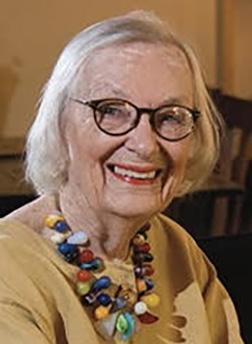
tle cool, and more importantly, there was a refrigerator to chill the champagne.
The wedding was everything it should be: beautiful bride, handsome groom, perfect weather, ideal location.
My granddaughter Sydney was marrying Liam, her true love and best friend.
They stood in front of an ancient oak, clasped hands, and, prompted by an officiate, repeated their vows.
Husband and wife, they turned and faced us, family, friends.
Done.
Simple. Not.
Took a year, maybe two or three of planning.
I thought of how different weddings can be, yet the basics are the same. Outdoor weddings, like the one for the newly wed Mr. and Mrs. Finn at Honey Horn Plantation, are definitely a challenge.
Granddaughter Anna Catherine and her Blaine planned a bucolic beach wedding on Hilton Head, complete with a floral arch bursting with blooms and calm afternoon sea breezes.
Oops, an unwanted, unexpected, last-minute superstorm named Ernesto raged across the Lowcountry. Rain came pouring down. The wind blew fiercely.
The bursting-with-blooms floral arch, now a shade bedraggled, was moved inside to where tables had been set up for the wedding dinner. The displaced ceremonials were held on the dance floor. Improv on steroids.
Yet another granddaughter married in the garden of a French castle. Who would have thought there would be an October heatwave in the Pyrenees’ foothills? Fortunately, massive stone walls kept the cas-
The funniest—no, not funniest—was an “I can’t believe this” outside family wedding in Edenton, North Carolina. The garden was gorgeous, weather sublime. Guests were seated in those fancy white folding chairs neatly lined up, bride’s side on the left, groom’s on the right. Everyone dressed to the nines.
Music softly played. Lots of Mozart. On and on. We waited for that special “Here Comes the Bride” tune. And waited. We visited. One guest left to make her hair appointment. She came back, freshly coiffed. We were still waiting. At long last, as the sun was setting over the bay, the bride appeared, absolutely stunning, beautiful in her wedding gown. The ceremony was a hiccup long. Finally, they were husband and wife. Time to go across the street to Wessington’s garden, where tables dressed with white cloths, flower arrangements, and lamps sheltered by hurricane glass chimneys were set up around a wooden dance floor, food was divine, shag music was North Carolina ready, and best of all, the bar was open.
We flew way out west for grandson Daniel’s wedding. It was an intimate outdoor ceremony at his Nevada home. The garden was small, Zen-like, with a soupçon of manicured grass protected from view and desert winds by a solid fence. Daniel and Justine, his lovely petite bride in her gown of satin and lace, exchanged vows before immediate members of the family. Then, off to a private room at a local Las Vegas casino for dinner and a serious bout of line dancing.
Another wedding that was a tad different had nothing to do with gardens or our family, but it intrigued us Savannahians.
Robert C. Roebling, whose great grandfather John A. had built the Brooklyn Bridge, raised black Angus cattle at Modena Plantation on Skidaway near Savannah back in the days before there was a bridge to that island, and they commuted by boat from Isle of Hope. The site of the plantation’s annual cattle auction was a circular

14,000 square foot barn used to host the wedding in 1950 of Roebling’s lovely 23-year-old daughter Ellin Cochran to James Hermann Hagan of Sylvania, Georgia - flowers and potted palms, music and light libations, orchid corsages, and whiffs of Chanel No 5.
Northern hospitality, Southern style. Weddings can be costly, which is the understatement of the year. No one knew this better than Japanese couples in the 1960s who took advantage of a package deal offered by the Salvation Army in Hawaii. For a flat fee, everything needed, including obi, kimono, headpiece, and clogs, a wedding could be had with the service conducted in a charming lava rock chapel on the island of Oahu. The whole shebang, including airfare, was cheaper than a similar wedding in Japan. I drove past the chapel many times on my way to the Salvation Army’s Waioli Tea Room for lunch. From its lanai you could see the grass shack in which Robert Louis Stevenson, author of Treasure Island, on an 1840’s visit to Hawaii spent many an hour. Aloha, brah.
Then, there were church weddings.
One daughter married in Bluffton’s Church of the Cross on a summer day so hot you could have fried an egg on the sidewalk. The air conditioning was out in the parish hall. Shortest reception ever.
Another trotted up the aisle at the
Evangelical Lutheran Church of the Ascension. Lovely wedding. However, we don’t have a single picture. I’m still not sure what happened to the photographer. He was there. In the balcony. Totally zoned out?
Nothing went wrong at the Sacred Heart wedding in Savannah unless you count us running around like chickens with their heads cut off trying to find a safety pin when a bridesmaid’s zipper broke just before the service.
George William and I had the best wedding ever.
If you have a free hour or two, I’ll tell you all about it.
But I have to laugh to myself, thinking about Papa Harrell, who balked at wearing a tuxedo and what he called “all the folderol.” He graciously offered to give us $50.00 if we would run away to Ridgeland and be married by the Justice of the Peace.
Ah, but then who would have caught the bouquet?
Annelore Harrell’s journey is a tapestry woven with fascinating experiences and extraordinary accomplishments. Even at 92 in 2025, Annelore’s energy and zest for life continue to inspire. Annelore Harrell’s story is a testament to living with passion, resilience, and an unquenchable thirst for adventure.

By Kevin Fitzpatrick Contributor

I consider myself incredibly lucky in so many ways but one of the simplest, yet most long lasting, is my love of reading.
I don’t remember when it began but one of my earliest memories was the collection of newspapers my dad would bring into the house each day. We lived in a second floor walk up in the Bronx, NY and on the corner, next to the entry to the Subway, was a green newsstand. My dad would pick up The New York Daily News and The New York Times on the way to work and on the way back from his job as a bus dispatcher, The New York Post as it was, at that time, an afternoon publication only.
On the weekends, as soon as I was old enough, he’d send me out to pick up the Sunday editions of the News, Times, the Journal-American and the Herald-Tribune since there was plenty of time to read them all. I started reading the various comic sections before I even went to school, then the sports sections for the results and stats of my beloved Yankees, and Football Giants as I got older. When I was first married, it became tradition to go out on Saturday night and pick up the early edition of the Sunday New York Times so that we could be
among the first to find the upcoming concerts which were announced in the Arts and Leisure section and make plans to get on line for tickets (no internet or phone orders, and even the brand new Ticketmaster required you to show up and line up.)
All of this is to set the stage for how I became enamored of reading. My dad, as mentioned, was a NYC Bus dispatcher. My mom, who didn’t go back to work as a secretary, until I was 11 and my sister had started school. My younger sister and I never wanted for anything but our folks always lived paycheck to paycheck and never owned a home of their own until after they both retired and purchased a small condo in VT (that they never moved into but that’s a story for another piece).
They had to be careful with how their paychecks were spent, but one of the things they never hesitated to allow me to buy were books. We were lucky enough to have a branch of the NYC Library right around the corner, but when I would get frustrated that what I wanted was either not there or checked out, I would go to the local book shop. The Hardy Boys and Tom Swift series gave way in pre-teen years to the entire James Bond series.
When I started high school at Cardinal Spellman, one of the first things that arrived in the mail as an entering freshman, was the summer reading list. It was required that you read 15 books over the summer, 5 were mandatory, the rest were from a very long list of suggestions. While that may seem like a lot, they had the list structured in a way that there were some not so large, think Red Badge of Courage
as an example, gradually, as you went down the list to Frankenstein, or Dracula as examples of longer works. There were biographies, historical works, poetry, classics (Dickens and Shakesphere were always included). It was set up in a way to make a seemingly impossible task doable for everyone.
Some of my favorite reads to this very day came from that experience, and the discussions of Mary Shelley’s epic work Frankenstein still resonate, the idea of it only couching the actual intent behind the use of a “monster,” and why she actually wrote it, how difficult it was for her to actually get it published with her name on it (we were given historical perspective during the discussion as well.)
That brings me back to the newspaper as the generator of my love for reading. When my daughter was born in October of 1980, we were living in Lenox, MA and one of the things I always did very early on Sunday morning was to go out and grab The New York Daily News and The New York Times before the limited quantity sold out. I would then come home and sip my morning coffee while having my daughter rocking in her little seat on the table while I read the papers and gave her the colorful comics to play with to keep her occupied.
I noticed that at about 3 months old she was turning the comics “right side up” and seemed to be noticing not just the pictures but the words, that continued along with a nightly story being read to her before bed, until around age 4 she would ask to read the story to us. So, I guess there is something to what that hard copy of the
newspaper meant to both of us from the beginning.
While I am well aware that reading has morphed from holding the paper or the book for many and, in fact, print editions are becoming less and less available and for many desirable, there is a magic that still takes place when you are sitting around a pool, or at the beach, or in a plane or just in your living room and turn page by page to find out what the outcome is.
One of the joys of this part of the Lowcountry is knowing that Pat Conroy took most, if not all, of the inspiration for his works from this area, and having read many before, I found far more in those works once we moved here and I was able to relate to locations, themes, and to the point of being able absorb the feelings of the weather that I couldn’t do when I first read them.
To read is to explore without leaving your chair. A good friend posted this saying a while back, I think it explains why I find such pleasure in holding a book as I read, why I hope those of you who are reading this are holding the print edition and turning the pages. I also think it’s a great coda:
“The thing about reading is that, in that very moment, while your nose is stuck in that book, all your troubles fade and you and your book are the only two things in the world.”
Kevin Fitzpatrick is a retired teacher who, along with his wife Sue (also a retired teacher) is enjoying exploring life in the lowcountry and all it has to offer.
By Ryan Chowansky Contributor

I would like to provide you with a behind-the-scenes look at how intentional planning protects your budget, your time, and your peace of mind.
If you’ve ever had a construction project spiral out of control with missed deadlines, surprise costs, and communication breakdowns, there’s almost always one root cause… poor planning. Want to know the truth? I’ve been there. I’ve rushed project starts to meet unrealistic requested timelines because I didn’t want to lose the job. And I’ve paid the price.
If there’s one thing we’ve learned after years of remodeling and building homes in the Lowcountry, it’s this: Proper planning prevents poor performance.
When I was working in the marketing world for a large insurance corporation, our leader was a weathered, rough, Marine Gunnery Sargent. He added an extra “P” in between “prevents” and “poor,” but I never forgot the phrase. It’s more than a catchy phrase. It’s the difference between a project that runs smoothly and one that turns into a stressful disaster.
So, what does proper planning actually look like in our world now?
Here’s how we do it step by step.
It starts with a conversation, not a quote. We don’t believe in fast quotes based on a five-minute walkthrough. We believe in understanding. We take time with you.
That means sitting down to discover such items as: What is your ultimate desired outcome? What’s driving this project, space, style, functionality, resale? What’s your ideal timeline and investment range?
I’ve had homeowners call us in for an addition, and after listening to what they actually needed, we were able to save them tens of thousands by remodeling what they already had. That came from
actually listening to what they needed, not just hearing what they wanted.
Then, we move into discovery and feasibility. This is where proper planning really starts to happen.
We create a design and feasibility agreement so we can define the scope clearly, create a realistic design within your goals and budget, explore materials, layouts, and options side by side, and catch issues before we even get the quote together.
When you travel, your ticket tells you where you’re starting from and your destination, when to arrive, when you leave, when the gate closes and what gate to use, your boarding class and even where you’ll sit. That’s exactly what our Design Agreement does for your project. It gives you all the details in one document with a clear map of how we are going to get there together, safely, comfortably and unlike flying on Spirit, no fights should break out mid-flight if we do this right!
Before we move into production, you’ll have a finalized set of plans, a clear breakdown of pricing, an honest timeline based on labor and material availability, and a plan for selections, permit-
ting, and prep work.
This is what helped us avoid a 12-week delay in a Hilton Head Plantation butlers kitchen last year. We flagged a long-lead tile material early and found an alternative before the demo even started.
We can start strong because we planned smart. Once we break ground, things move quickly, not chaotically. Everyone’s on the same page. Expectations are set. Your materials are ready. Your project manager has a game plan, not just a to-do list, scrambling at the last minute.
The result? Fewer surprises. Fewer change orders. Fewer headaches. And a better experience from start to finish. You don’t get a dream project by winging it. You build it by planning well. So whether you’re ready to start next month or just thinking about next year, start by finding a builder who values the plan and the process as much as the product and price tag.
That’s how you protect your investment and your peace of mind.
Ryan Chowansky is the owner of Bluffton Builders, LLC, www.bluffton.builders.
trusted choice for inpatient rehabilitation
Encompass Health is the largest system of rehabilitation hospitals, trusted by patients, caregivers and medical professionals.
Encompass Health is the largest system of rehabilitation hospitals, trusted by patients, caregivers and medical professionals.
Encompass Health is the largest system of rehabilitation hospitals, trusted by patients, caregivers and medical professionals.
Encompass Health is the largest system of rehabilitation hospitals, trusted by patients, caregivers and medical professionals.
Encompass Health is the largest system of rehabilitation hospitals, trusted by patients, caregivers and medical professionals.
We are proud to support the American Heart Association’s Heart Ball.
We are proud to support the American Heart Association’s Heart Ball.
We are proud to support the American Heart Association’s Heart Ball.
We are proud to support the American Heart Association’s Heart Ball.
We are proud to support the American Heart Association’s Heart Ball.

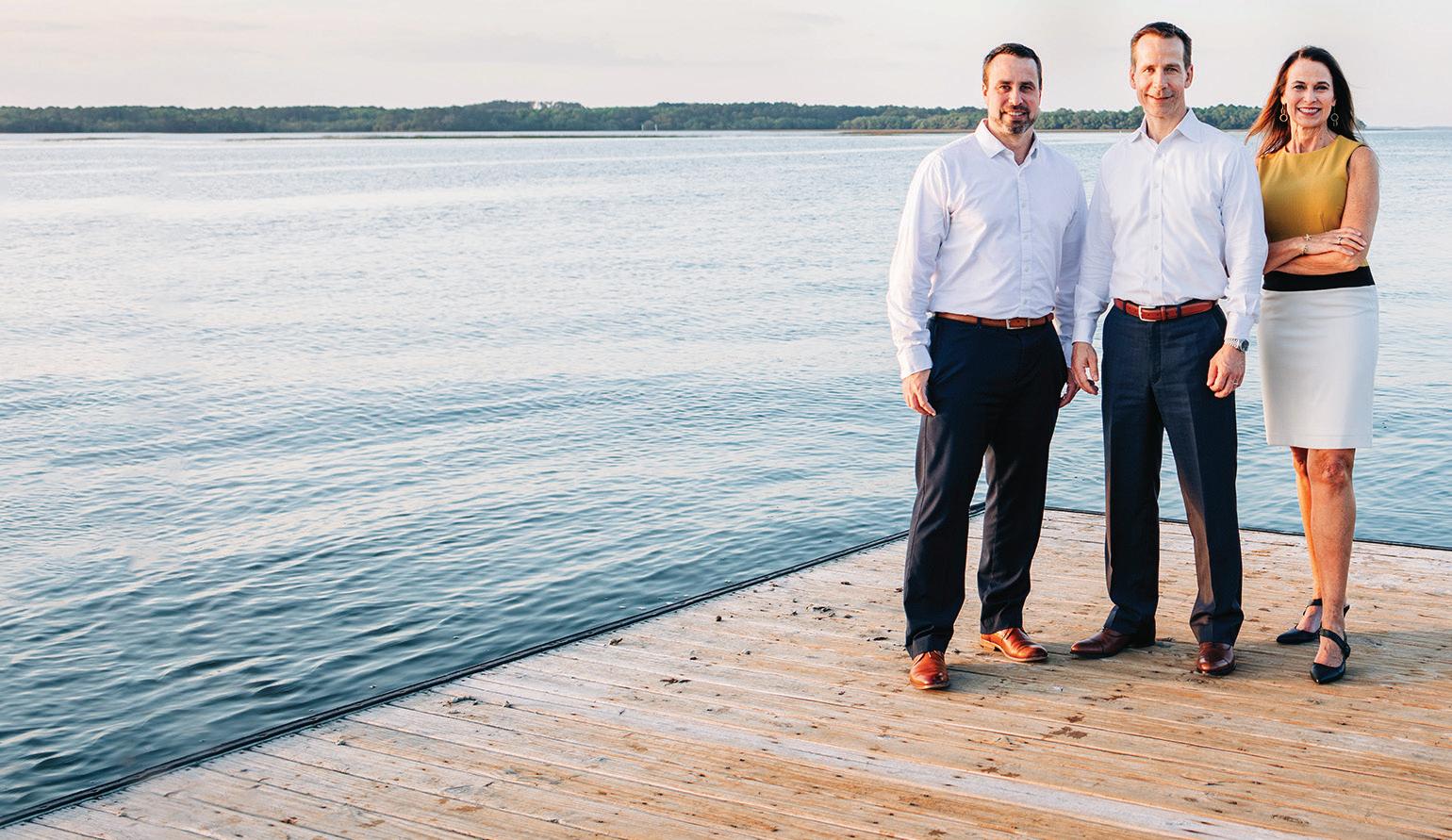
IT’S NOT JUST A 401(K)
IT’S A SMARTER
We help successful business owners turn their retirement plans into powerful tools for growth, retention, and long-term wealth with: CUSTOM PLAN DESIGN & OPTIMIZATION | ONGOING INVESTMENT & FEE BENCHMARKING PARTICIPANT EDUCATION & ENGAGEMENT SEAMLESS INTEGRATION WITH BUSINESS & PERSONAL GOALS
Let’s discuss how to align your 401(k) with your business and personal wealth strategy—so every dollar works harder for your company, your team, and your future.
The Village at Wexford Hilton Head Island 843.420.1993 infohh@allianceg.com agplowcountry.com















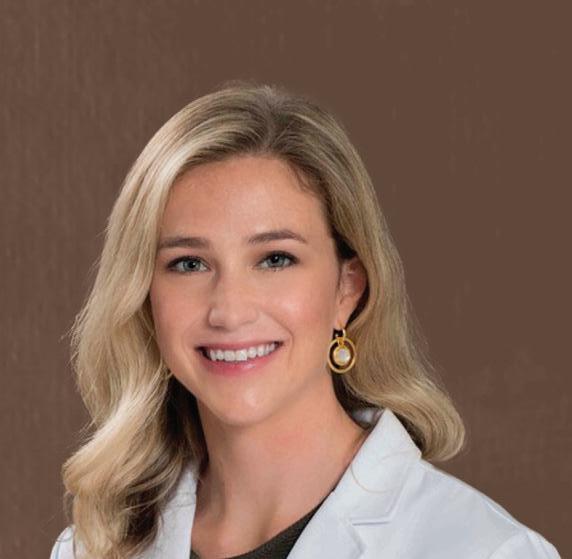
By Dr. Matthew Mastrorocco Contributor

of all ages?

• What dental technologies do you use?
• How do you help patients with dental anxiety?
• What’s your process for new patient consultations?
• Can you explain how you present treatment plans and options?
• Are you involved in the Bluffton or Hilton Head community?


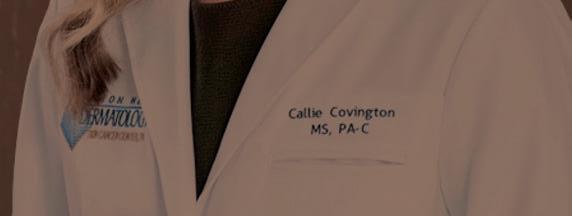


•
•
•
• Exilis
• Microdermabrasion
• RF Micro Needling
• Botox



Moving to a new town comes with a long list of to-dos: unpack boxes, find the nearest grocery store, update your address, and—eventu-
ally—choose a new dentist. There are many options, and the internet offers a sea of reviews, but how do you know who to trust?
Look for a practice that feels local — not just professional
When you’re new to Bluffton or Hilton Head, you want more than just someone who can clean your teeth—you want someone who understands the people, pace, and personality of the area.
A great dental office should reflect that community spirit. Are they involved in local events? Do they support charities, schools, or neighborhood initiatives? These things may seem small, but they speak volumes about how invested a practice is in the people they serve.
What to look for in a dentist
As you begin your search, here are a few key qualities to look for:
1. Advanced technology
Dental care has come a long way, and you deserve a practice that keeps up. Look for a dentist who offers digital imaging, laser treatments, and other modern advancements that make appointments more efficient and comfortable.
2. Friendly, professional staff

have dental anxiety.
3. Experience with families
If you’re moving with children— or planning to start a family—finding a dental home that can grow with your family matters. A family-focused practice will offer both pediatric and adult care, making scheduling more convenient and fostering trust across generations.
4. Gentle care for anxious patients
Let’s face it: not everyone loves going to the dentist. A compassionate dental team understands this. They listen without judgment and explain procedures in plain language.
5. A Commitment to the Community
Bluffton and Hilton Head are more than just scenic destinations— they’re tight-knit towns where people care about their neighbors. A dentist who shows up for their community is likely to show up for you, too.
Their answers will tell you a lot about their values—and how comfortable you’ll feel under their care. Don’t skip the reviews (but read them with context)
Online reviews can be helpful, but it’s important to read them with a discerning eye. One or two negative comments are normal for any business. What matters is how the practice responds and whether the majority of patients describe a consistent, positive experience.
Look for phrases like: “They made me feel comfortable.” “The staff was so kind.” “They helped me overcome my fear of the dentist.” And “They explained everything and gave me options.”
Those are signs of a team that truly prioritizes patients.
Dental care isn’t just about your teeth—it’s about your overall health, your confidence, and your ability to enjoy life fully. A great dentist doesn’t just treat problems—they help you prevent them, educate you, and support your goals, whether that’s staying cavity-free, restoring your smile, or simply not dreading your next appointment. The right dental home will feel like just that: a home. Somewhere you feel welcome, cared for, and never rushed or judged.


Your experience begins the moment you walk through the door. A warm greeting, a calming atmosphere, and a team that genuinely cares can completely change the way you feel about going to the dentist. This is especially important if you
Once you’ve narrowed down your list of potential practices, don’t be afraid to ask questions. The right dental team will welcome them.
• Do you see families and patients
Matthew Mastrorocco, DMD is the owner and founder of ROC Dental Group, serving Bluffton and Hilton Head Island.
By Dan Prud’homme Contributor

The Hilton Head Island real estate market continues to move at a brisk pace as we head deeper into summer, with buyer activity picking up and inventory beginning to tighten. After a brief spring slowdown, recent numbers suggest that the market has regained its footing.
Average days on market dropped significantly to 56 days, down from 77 in June, a 27% decrease in just one month. That’s not only a strong month-overmonth shift, but it also puts us right back in line with July 2024, when DOM also
hovered in the mid-50s. For context, July 2023 saw an average of 70 days on market, so we’re still trending ahead of the pace we saw last summer.
Inventory has also shifted. As of early July, there are 919 active listings, compared to 943 in June, representing a 2.5% decrease. This reverses last month’s trend of rising inventory and may point to increased buyer absorption as we move through the summer months. A year ago in July 2024, inventory stood at 901 properties, so current levels are almost identical to what we saw then.
Closed sales rose to 170 this month, up from 162 in June, a 4.9% month-overmonth increase. This uptick marks the highest monthly closing count so far in 2025 and reflects both the seasonality of the Hilton Head market and the return of some pent-up buyer demand.
The list-to-sale price ratio dipped slight-
ly to 95.7%, down from 96% last month, continuing a trend we’ve seen for much of 2025. In July 2024, the average ratio was just under 96%, so while sellers are still getting strong offers, buyers are enjoying a bit more negotiating power than they did during the peak of the market frenzy.
One of the most telling figures is the median sale price. This July, the median home price on Hilton Head Island reached $1,207,450, up from $1,028,375 in July 2024. That’s a 17.4% year-over-year increase, and a striking 54% increase over July 2021’s $785,667 median. This five-year climb highlights the extraordinary appreciation we’ve seen since the pandemic began.
So, where does that leave us? With 919 homes on the market and 170 sales per month, Hilton Head is currently operating at just under a 5.5-month supply, suggesting a market that is approaching balance
but still slightly favors sellers. Properly priced homes in desirable areas are moving quickly, and the latest data shows that buyers remain active despite elevated borrowing costs.
Looking ahead, expect a strong close to the summer season. Barring any economic surprises, we anticipate a competitive fall with buyers trying to get ahead of any shifts in interest rates. If you’re considering a move—whether buying or selling— this is a great time to be educated and ready.
Talk to you next month!
Dan Prud’homme
Dan Prud’homme is the Visionary & Success Coach of The Prud’homme Team at William Raveis Real Estate. dan@danprudhomme.com theprudhommeteam.com












By Collins Doughtie Contributor
Since I usually write my column a week or two before being published, this time around seemed like the perfect time to sit down and knock out one of my rambling, hodge-podge of words complete with atrocious grammar. Hopefully it is sunny outside as you read this because as much as we needed the rain, we sure as heck have put a dent in the that dry spell in this last week and a half.
Take last night for example. If you are anywhere around Hilton Head, Bluffton or Beaufort the storms that rolled through here last night were absolute frog chokers. The first storm cell barely moved as it settled over my hacienda and the raindrops were the size of lima beans. The part that really amazed me about this deluge was the lack of any wind at all. The limas were falling straight down with hardly a space between each bean. According to my rain gauge I got nearly three inches in less than 30 minutes. That is dumping!
Then, an hour or so later, the second storm cell approached. It too put a dent in the frog population but it was the light show that dazzled me. Most folks hide under the beds during lightning storms like that, but for whatever reason I can’t help but grab an umbrella and step outside to watch.
I guess most small children are comforted by their parents during severe thunder storms, with some explanation as to what is making all that racket. Mine was “it’s just angels moving furniture” or “the angels are bowling.” If that is indeed

the case, then every single angel was up there moving grand pianos or some equally big piece of furniture last night and not one of them could decide where best to place the piece. “Honey, move it a bit to the left, no a bit more. Maybe it would look better over by the window.” You get my drift, right?
If my children were still toddlers, I would have explained that storm as angels having one of those old school dance contests like they had in the 1940’s where the last couple standing wins. There was nary a pause between flashes for more than an hour. As the storm finally started moving out toward the ocean, I walked down to the May River and watched. The lightning was horizontal, not vertical, and some bolts split off into dozens of fingers that etched across the entire horizon.
With all this wild weather flying around, fishing has been out the question for the past week. Thinking ahead about this column’s theme (something I rarely do) I began scratching my head about the time the first rain hit, knowing that the rest of the week was to be more of the same. I seriously hadn’t planned on eating up space talking about thunder storms and lightning, but those thunder boomers last night were just way too spectacular not to mention.
Many of my columns come from inspiration that hit me in the oddest places or at the most unexpected times. Having pretty much blown what I had intended to write about, hopefully I have enough space left to tease you a bit.
Since I have spent most of my life in the
world of art and design it should come as no surprise that I am avid watcher. Even when driving, if I catch a glimpse of some bird way up riding the thermals I have to look. Is it an eagle, an osprey or maybe a swallow-tailed kite? It’s just my nature. The same goes if I am on the water or walking my beagle. I cannot tell you how many once-in-a-lifetime events in nature this trait has afforded me. If I had a video camera implanted in my skull I would rich right now by selling the film to National Geographic.
It was during a lull in the weather while walking my beagle Butterbean that I caught a glimpse of some red bricks partially covered in dirt. Exciting huh? Actually - it was, because as got closer I saw that the bricks were settled at the base of a tree and the roots had conformed perfectly to the 90º edges of the bricks.
To top that off, some sort of bird (I suspect a hummingbird by the size of the nest) had built its nest on this natural sculpture completing this one in a million piece of art. It was as if I had discovered a masterpiece hidden under another artist’s sub-standard painting.
Between frog choker rain storms, sheet lightning and my newly acquired piece of art, I would say nature is on a roll. Taking a line out of my favorite Pink Floyd song to praise all that nature gives me, “all in all it’s just another brick in the wall.” And folks, what a wall it is.
Collins Doughtie is a 60-year resident of the Lowcountry, is a sportsman, graphic artist, and lover of nature. collinsdoughtie@icloud.com

By Matt Uppenbrink Contributor

The decision to transition to an Independent Living community represents a significant life choice, and many struggle to identify the optimal timing for this lifestyle change. Rather than waiting for declining health or mobility issues to force the decision, many suggest recognizing the proactive indicators that signal readiness for independent living that can lead to more positive and fulfilling experiences with this choice.
One of the clearest signs that it may be time to consider an independent community is when home maintenance begins to feel overwhelming rather than rewarding. “Tired of spending 60 hours per month on housekeeping?” is a question resonating with many adults approaching retirement age (A Place for Mom, 2024). The endless cycle of yard work, home repairs, and household cleaning and management can consume precious time that could be better spent on personal interests, like sports and hobbies and keeping and growing your relationships.
Many prospective community members discover that the maintenance-free lifestyle offered by independent living allows them to reclaim their weekends and redirect their energy toward more meaningful pursuits. When thinking of climbing ladders to clean gutters or spending entire Saturdays on lawn care begins to feel more like a chore than a choice, it may signal readiness for a different living arrangement. And if your green thumb becomes itchy, many communities have member gardens or workshops to get those DIY hands dirty! Another Lowcountry feature that many communities in our area offer is
help with hurricane planning or even all-inclusive hurricane evacuation services that can allay concerns of the “where to go and how to get there” questions if a weather event requires leaving the area for safety, plus any clean up and repairs after a storm.
Desire for deeper social connections often emerges as a key motivator for exploring independent living. Many adults who find themselves spending increasing amounts of time alone, particularly after retirement or the loss of a spouse, may benefit from the inviting and open social structures these communities provide.
Isolation that can accompany traditional suburban living becomes more pronounced with age, especially when adult children move away and longtime neighbors relocate. Independent living communities address this challenge by creating environments where “neighbors build lasting friendships and often become close like a family” (Where You Live Matters, 2024). In my experience in senior living, I’ve seen amazing friendships develop in these communities, making these years some of the most significant in terms of person relationship growth, comfort, and understanding.
The emphasis on active living within the independent living communities offers significant health advantages that extend beyond simple convenience.
“Specific health benefits associated with staying active and social in a 55+ community include: reducing the risk for cardiovascular problems, rheumatoid arthritis, some cancers and osteoporosis” (Messiah Lifeways, 2025). These communities typically feature “fitness programs, wellness classes and opportunities to engage in physical recreation activities” (Private Communities).
The decision to move to an independent living community often coincides
with significant life transitions such as retirement, downsizing, or the desire to simplify financial obligations. Many adults find themselves maintaining homes that no longer match their current needs or lifestyle preferences.
Additionally, the predictable monthly fees associated with many of these communities can provide financial security by eliminating unexpected major expenses like roof repairs or HVAC replacements. This financial predictability becomes increasingly valuable on fixed incomes.
The ideal time to consider independent community living varies significantly among individuals, but common themes emerge. Those who value their independence while desiring reduced responsibilities, who seek active social engagement with peers, and who prefer to make housing decisions proactively rather than reactively often find the transition most rewarding.
The key lies in honest self-assessment about current satisfaction with living arrangements, future goals, and personal priorities. When the vision of community amenities, social opportunities, and simplified living begins to outweigh attachment to current housing, the timing may be right to explore available options.
The decision to move to an independent living community should feel empowering rather than limiting, representing a positive step forward to a lifestyle that better aligns with current needs and future aspirations. By recognizing the signs early and planning accordingly, adults can make this transition during a period of strength and choice rather than necessity.
Matt Uppenbrink, MS, is the Executive Director of The Seabrook of Hilton Head. Interested in learning more about The Seabrook of Hilton Head or if you would like to schedule a tour: https://www.theseabrook.com/ or call 843-842-3747.

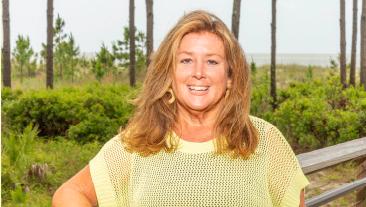



By Rev. Therese Donlan Lee Contributor

Welcome July, the month wherein we are called to celebrate freedom not only as a collective reality but also as an inner truth.
As a UNITY Minister, I see freedom as a spiritual awakening - a stirring of the inner divinity within each of our souls. In Unity, we understand that all outward manifestations begin within; hence, for us to honor freedom fully, you and I must first embrace it in the silence of our own mind and hearts.
Freedom is the very essence of God (by whatever name you all it) moving in, through and as us, bringing each of us
into harmony with the divine order of our lives. The founding of this great nation was a historical act and a deeper declaration - what we call in UNITY a spiritual affirmation - of the liberty bestowed upon each of our souls to seek communion with the Infinite (God).
Each day brings us the sacred opportunity to craft our own declaration of independence, a living proclamation written in the language of our own spirit. I invite us all to loosen the chains of old thought patterns and BS (belief systems) that no longer serve the truth of our divine identity.
This sacred act of unbinding is an internal evolution - a holy shift, a transformation, that aligns us with the universal flow of love, higher consciousness and divine wisdom. The truth that sets us free is not found outside of us, it is found in the stillness of our inner personal sanctuary within.
As scripture tells us, “You shall know the truth, and the truth shall make you
free.” The key word for me is “know.” This truth is a divine revelation, a light that dispels the shadows of our fears and egos. This truth is an awakening of us to the infinite potential of divine connection. Through this light of truth, we begin to see ourselves and others as expressions of God’s unconditional love and intelligence, letting go the lenses of limitation and judgement.
In this radiant awareness, we see ourselves and others through the lens of divine equality, embracing the sacred individuality that each soul embodies. “You be you, and I’ll be me,” has become not just a phrase, it is a profound acknowledgement, a metaphysical mantra for me that honors the unique vibration, the divine perfection of every single being.
And, I now joyously add, “Let them,” thank you to Mel Robbins. Let us allow the divine consciousness within each of us to rise, bursting forth like July fireworks from the confines of old paradigms and limited thinking, illuminating the
world with the radiant glow of God-inspired, Spirit-led, open-minded thought.
In the quiet stillness of divine commUnity, we claim our spiritual independence as a deeper connection to the eternal presence of God within. This presence empowers us to rise above circumstances, to pursue happiness, liberty, and peace with hearts open to the flow of divine love and curiosity.
In the quiet stillness of divine wisdom within every single one of us, we get to claim our spiritual independence. We call forth the awareness of God as the eternal presence everywhere present –the living, loving presence that empowers us to pursue joy and the divine harmony of being all we have come here to BE. And so it is! Sparklers and blessings to all.
Rev. Therese Donlan Lee is the senior minister of Unity Spiritual Center on Hilton Head Island. revthereseunityhiltonhead@gmail.com
By Rev. Dr. Jon R. Black Contributor

Life is full of twists we never saw coming—betrayals, illness, injustice, grief. And if we’re honest, some of what we experience is not just inconvenient or difficult— it is evil. The world is broken. That’s not how God designed it to be, and it’s certainly not how God desires it to remain. But even amid the brokenness, even in the face of real suffering, God remains present. One of the most enduring truths I’ve carried with me came from a dear friend, Father Dallas, who would often say, “God writes straight with crooked lines.”
I first met Father Dallas while serving as a Navy Chaplain. His quiet wisdom and deep faith helped anchor many of us in seasons of disruption. He never used that phrase to minimize pain or explain away suffering. On the contrary, he understood that some things should not happen. But
still, he believed—and helped others believe—that God could redeem what was meant for harm and bring forth good from it.
This belief doesn’t ignore the reality of evil. It recognizes it. We live in a world marred by human sin, injustice, violence, and loss. God does not cause these things. It is not God’s will that we suffer. But suffering is, tragically, a part of life in a fallen world. The hope of our faith is not that we are spared hardship—but that God does not abandon us to it. God is constantly working to bring healing, justice, and new life, even from the ruins. Nowhere is this clearer than in the story of Joseph in the book of Genesis. Evil actions upended Joseph’s life—his brothers betrayed him and sold him into slavery. Later, he was falsely accused, imprisoned, and forgotten. For years, it seemed as if evil had the final word. But God never stopped working. Over time, Joseph rose to a position of influence and was able to save a nation—including the very family that had once betrayed him. Joseph didn’t excuse what had been done to him. He named it clearly: “You meant it for evil.” But he followed that truth with a greater one: “God meant it for good.”

This is the redemptive thread of our faith. God does not will the evil that comes into our lives, but God is not defeated by it either. When we walk through dark valleys, we are not alone. When our stories feel derailed, God is still writing. Every crooked line, every unexpected turn, every painful chapter—none of it is wasted in God’s hands.
So when life breaks our heart or shakes our foundation, we must remember: God
is not the author of evil, but God is the master of redemption. The pen is still in God’s hand. And yes, God writes straight with crooked lines.
By Rosemary Staples Contributor

Every year, up to 800,000 martins migrate to their breeding grounds in North America from Brazil. They fan out across the entire United States and into Canada in search of birdhouses on farms, fields, lakes and rivers. Meanwhile, “martin landlords,” welcome their arrival with clean, spacious homes to raise their new broods.
In South Carolina, Purple Martins arrive in February and stay through August. Males are recognized by their glossy, midnight blue feathers, while the female is duller with lighter underwings. Early arriving birds are sometimes called “scouts,” but these are actually older birds getting a head start on last year’s housing. On Hilton Head, the Sea Pines community garden has erected eight martin “condos,” complete with wraparound porches. Provided homes remain clean and safe from predators, martins return every year to the same nesting site.
Purple Martins are called “aerial insectivores.” They forage on flying insects “in mid-air, on the wing. Contrary to popular myth, mosquitoes account for only two percent of the martin diet, not 2,000 a day. The oft-claimed quote stems from an ad campaign for martin houses that stated, “Purple Martins CAN eat 2,000 mosquitoes a day.” Perhaps they can, but they don’t. Martins forage high in the air on large dragonflies,
bees, beetles and wasps. Mosquitoes hang close to the ground so their flight paths seldom intersect.
Purple Martins have cohabitated with humans ever since Cherokee tribes enticed them to their villages with hollowed gourds. American settlers followed suit, tempting the sociable birds with impressive gourd racks and apartment-style homes. It was a win-win deal — safe housing in exchange for pest control. In 1831, John James Audubon wrote in his travels across America, “Almost every country tavern has a martin box…the more handsome the box, the better does the inn generally prove to be.”
Though impossible to determine, educated estimates suggest the Purple Martin population numbered 70 million in the mid-1800s. Audubon described “prodigious numbers” of martins around the country and wrote about a flock in New Orleans that was “a mile and a half in length, by a quarter of a mile in breadth.” But martins lost out in the nineteenth century when vast forests were cleared in the eastern U.S.
About the same time, invasive starlings and house sparrows from Europe were released into America, and they hijacked the tree cavities where martins once nested. Today, Purple Martins east of the Rockies are almost totally dependent on people to provide nesting sites. They are on the Watch List; their numbers have declined 25 percent since 1966, primarily due to habitat loss and overuse of pesticides.
The current worldwide population of Purple Martins is 9.3 million. An estimated 900,00 landlords volunteer in the U.S. and Canada, but 95 percent are fifty years and older. Groups like the Purple Martin Conservation Association and the National Wild-


life Federation work to promote and provide opportunities for younger generations to become landlords, citizen scientists, and volunteers to reverse the martin’s decline.
As you read this article, Purple Martins are preparing to fly back to South America for the winter. But first they gather in enormous colonies called “roosts,” where hundreds of thousands of birds meet to rest, refuel and socialize before leaving on their 3,000 mile journey back to Brazil.
The largest Purple Martin roost in the country is three hours away in Columbia, South Carolina. Since the 1980s, up to a million martins have gathered on Lake Murray’s Bomb Island, a former military training site in WWII. In July and August, skies
appear as living clouds of darkened birds swirling, twirling, dipping and diving over the island. More an avian force than a flock of birds, boaters gather round all summer, mesmerized by the natural phenomenon. The roost is Lake Murray’s must-go summertime show; tours and boat rentals can be made online for a reasonable fee.
Learn more about attracting Purple Martins at www.purplemartin.org or National Wildlife Federation www.nwf.org
Rosemary Staples is a member of Hilton Head Audubon, long time Lowcountry resident, writer, speaker, storyteller and Master Naturalist.

By Lindsay Perry Contributor
The winter storm of 2025 was a turning point for a shelter dog named Linus. We brought this charming, playful, 4-year-old boy to the Palmetto Animal League Adoption Center to spare him the long nights of freezing temperatures in an outdoor kennel at a rural shelter in our area.
“Poor Linus had dog bite wounds covering his entire body,” remembers PAL President Amy Campanini. “Once the snow melted and it was time for him to return, we didn’t have the heart to send him back.”
Once we got to know Linus at PAL, we discovered he is incredibly loving toward people. However, due to his past experiences, he is not fond of other dogs and, honestly, who could blame him.
“Linus needs a place where his heart can heal, and we want him to under-
stand that we won’t let him get into another situation where he has to defend himself against another dog,” explains Campanini.
Linus longs for a home where he can soak up all the love from his humans. In the right environment, he will be the most loyal, fun-loving companion anyone could ever ask for.
“His tail never stops wagging,” says dog caregiver Kaydence Collins. “He’s the kind of dog that never meets a stranger. Every new person is just a friend he hasn’t said hello to yet.”
Linus has a playful spirit and a soft spot for plush toys. He’s often seen trotting around the PAL Adoption Center carrying one of his prized possessions in his mouth. He also loves exploring the outdoors and basking in the sunshine whenever he gets the chance.
“He especially loves a good game of fetch,” says Collins. “He will happily chase a ball for as long as you’ll throw it!”
Linus is good on a leash, probably be-

cause there’s nowhere he’d rather be than right next to his person. He knows how to sit, does well in a crate, and absolutely loves a cozy dog bed!
“He is eager to please and picks up on new commands quickly,” says Collins. “He will thrive in a home that can provide structure, confident leadership, and above all, love.”
If you enjoy the great outdoors and need a positive, reliable adventure buddy, Linus might just be the perfect dog to do life with.
“He’s an affectionate dog with joyful energy and a goofy grin that’ll melt your heart,” says Campanini. If you’d like to meet Linus, visit PAL’s no-kill adoption center located at 56 Riverwalk Blvd. in Okatie, Monday through Saturday from 12 p.m. to 6 p.m. Your new best friend is waiting for you.
Lindsay Perry is the Marketing Coordinator for Palmetto Animal League. www.PalmettoAnimalLeague.org
The Town of Hilton Head Island has officially implemented new beach parking fee changes, effective June 24th, following a Town Council vote on June 17th, according to the town’s press release.
Under the revised schedule, weekend visitors will now be charged $5 per hour for parking at Town-managed beach parks, replacing the previous $20 flat daily rate. On weekdays, the former $15 daily maximum has been removed, and the $3 per hour rate remains in effect. Parking fees are enforced daily from 7 a.m. to 5 p.m., while parks remain open from 6 a.m. to 10 p.m., the release stated. The changes come as part of a broader effort to improve parking management and address the rising costs of maintaining and enhancing the island’s popular beach parks. “The research determined that previous parking fees were not aligned with the use of beach parks, as well as the subsequent need for increased funding to preserve, maintain, and improve beach parks,” according to the
town’s press release.
Coligny Beach Park, one of the island’s most frequented destinations, remains exempt from the new fee structure and continues to offer free parking. According to the town’s release, officials opted for a different approach at Coligny due to its proximity to a dense cluster of local businesses. Town staff are currently studying summer traffic patterns in the area to assess whether changes may be needed in the future.
Town of Hilton Head Island residents continue to receive free beach parking through a resident pass program, which the Town defends in the release by noting that “Hilton Head Island residents pay to preserve, maintain, and improve the Island’s beaches through various taxes and fees.” Consequently, the council determined residents should not be required to pay additional parking fees.
Town of Hilton Head Island residents who live at least 183 days per year in town limits may apply for up to two free digital
parking permits, valid year-round at all town-managed beach parks. Permits are limited to residents; non-residents are not eligible.
The town also addressed questions about Chaplin Park and Burkes Beach, which share a parking lot used by both beachgoers and youth sports participants.

Parking at this location remains free annually from early September through mid-May while youth sports are in session. The town said it would be impractical to differentiate between users and decided to suspend fees during those months.
Additionally, the town clarified that Beaufort County tax payments do not contribute to Hilton Head’s beach maintenance or preservation. Therefore, county residents outside the town limits are not eligible for free beach parking passes. Visitors must pay via the MyHHI app, as cash payments are no longer accepted. Fines range from $50 to $500 for violations.
For more information on beach parking policies, visit https://hiltonheadislandsc. gov/beach/parking/permit/
The next Town Council meeting is scheduled for July 15 at 3 p.m., for more information visit https://hiltonheadislandsc.gov/towncouncil.

This story is from a collection of interviews from long time locals who have generously shared their lowcountry memories with me to be saved for historical purposes and future generations
By Paul Tollefson Contributor

“The sand is too dark, and the water is too murky; it will never work”. This exact sentence was uttered in the mid-1960s from a potential investor, a wellknown, high-profile money man from New York, speaking on Hilton Head Island, and more specifically, the land that would become Palmetto Dunes: Oh, how wrong they were!
From the early 1900s up until the 1960s, what we know today as Palmetto Dunes, was used as a hunting club owned by the Hilton Head Agricultural Company; mainly for deer, hogs, racoons, and waterfowl. Many members would come on weeklong and weekend trips with folks from Gaston County North Carolina and surrounding areas and states.
It was a Tuesday morning in February of 1968, and Mr. Johnny White, V.P. of Palmetto Dunes Development Company was on a mission, a multimillion-dollar mission. It was midafternoon, and it was determined that two additional property plats were needed by the Clerk of Court and the closing attorneys to properly close the transaction. This needed to be done by the close of business that day. His mission was to drive from Hilton Head Island to Savannah Ga. to recover the two plats and get them to the Beaufort County Court-

house before 5pm. If he accomplished this trip, and all went as planned, they would be able to purchase and close on the 2,000+ acres of land in mid-island Hilton Head.
To those of you reading this, the trip from Hilton Head to Savannah is a daily commute in the morning before work and the return trip after work for many people. But remember we are talking about the 1960’s. Many of the roads of Hiton Head were no more than rutted up beach sand and dirt, the two lane 278 was nothing like the rapid and busy road we know today. This could take a while.
Mr. Johnny’s mission unfortunately did not go as planned and he knew that he was not going to be able to get from Sa-
vannah to Beaufort with the two recovered plats by 5pm, the close of business. But, that old phrase “It’s always good to know people in high places” came into play, as it has so many times to Lowcountry natives and long timers alike.
“We talked with the Clerk of Court, a friend of ours, and called in a favor. We asked him to please keep the courthouse open past 5 p.m. as I was on my way from Savannah and this business deal had to be completed by today.” said Mr. Johnny as he reminisced on this trip. “I made it alright, but it was darn near early evening by the time I reached Beaufort!”
“But there was still work to be done. Dowling, Dowling, Sanders, and Dukes, closing attorneys, met me at the court-
house on that Tuesday evening in February of 1968 and the 2,000-acre Palmetto Dunes deal went through.”
Why was it so important that the deal went through that day? Why didn’t Mr. Johnny just come back on Wednesday when the courthouse was open again? Why call in such a big favor to keep someone waiting till evening and have attorneys there?
Well, here’s the kicker.
Mr. Charles Fraser and family, responsible for the development of Sea Pines and the southern tip of Hilton Head, never thought these investors would be able to come up with the money needed to purchase such a big parcel of land on Hilton Head. Mr. Fraser was ready to purchase the property if it didn’t go through that day. He even went so far as to write the check for the property and give it to the closing attorneys, as he had such little faith that the investors would come up with the money.
What may have been? What if Palmetto Dunes was purchased by Charles Fraser, and not the Palmetto Dunes Development Company, would the old Leamington Lighthouse be painted in a red and white candy stripe like the iconic Harbour Town Lighthouse? We may never know.
My friend, Ms. Susan White Treadaway, a Bluffton local now, remembers when her father (Mr. Johhny White) moved them from Greenwood SC down to Hilton Head when she was around 4 years old. Although she remembers very little about her time in Greenwood, she fondly re-
members early Hilton Head Island, where she would grow up and never really leave.
“I can vaguely remember our first house which was located in the South Forest Beach area and my mother bathing my little sister in the kitchen sink as we did not have a tub. I remember going to Montessori School which was located on South Forest Beach when I was quite young. I remember the slide on the playground area that would slide us right into the dunes on the beach! I met my best friend, Tina Bates, at that time, and I am still best friends with her to this day! Tina’s father, Mr Charles Bates, actually designed the Hyatt in Palmetto Dunes.”
“When we moved to Palmetto Dunes,
none of the roads were paved yet. My friend “E” Robinson, son of EG and Peg Robinson, and I were always outside finding things to do with some of the other neighborhood kids. Sometimes we would climb underneath some of the bridges and make “mudpies” and make our younger siblings eat them!”
“As we got older, my mother, Alison Marshall White, would go on to open the islands first furniture consignment shop called Nearly New. Mrs. Peg Robinson worked there along with Mrs. Marianne Barker, Maynard Barker’s wife (Barker Field). Later, Peg and Marianne opened up their own consignment shop, Classic Consignments, which is still in existence to this day.”
Ms. Susan left to go to college where
she attended Lander University but came back to Hilton Head shortly after for a family tragedy. Today Ms. Susan can be found in her quaint cottage near the end of All Joy and Brighton Beach in Bluffton or working at Coastal Exchange in the plaza that once held Scotts Meat. (A fabulous store by the way, and owner Ms. Julie Hampton is a doll!)
When asked what kept Susan White Treadway here so long after her father had a hand in the development of Palmetto Dunes, she replied in such wonderful Lowcountry fashion:
“I can’t imagine living anywhere else! Sometimes I think it may be nice to live where no one knows me. But then when I walk into the Piggly Wiggly in Coligny and run into (owner) David Martin and
Hilton Head PSD’s Pete Nardi named national water conservation chair.
Pete Nardi, general manager of Hilton Head Public Service District, has been named Chair of the American Water Works Association’s (AWWA) Water Conservation Division and appointed to its Technical Education Council. The AWWA represents over 4,300 utilities nationwide.
Nardi, who has led the PSD since 2015, called the honor “an opportunity to help lead water professionals across the country in advancing conservation and efficiency.”
PSD earns 5-Year Safe Water Award.
Hilton Head PSD also received the 5-Year Directors Award from the Partnership for Safe Water for its rigorous efforts to optimize its drinking water distribution system. Water Quality Supervisor Sarah Hickman leads the utility’s self-assessment program.
“This award is recognition of the team’s commitment to quality for our customers and community,” said Nardi.
Audubon grant to boost conservation with new hire.
Hilton Head Audubon (HHA) has been awarded a $10,000 grant by the Communi-
ty Foundation of the Lowcountry to hire a Conservation Coordinator. The role will be filled by Denise Prichard, who will spearhead initiatives to protect local habitats and engage the public in environmental stewardship.
According to the organization, Prichard will lead shorebird protection campaigns, develop educational efforts under the “Safe Birds Need Safe Cats” program, and expand the Certified Bird & Wildlife Friendly Habitat Program. Her work will include collaborating with volunteers, schools, and youth groups such as Adolescents Advocating for HHA.
Sea Pines Resort welcomes new golf sales director.
John Haskins has been appointed Director of Golf Sales at The Sea Pines Resort. A Clemson University graduate with extensive experience in golf tourism, Haskins previously led group sales at a five-star resort and Charleston Golf, Inc. Mark Goodwin, Director of Sales and Marketing, praised Haskins’ industry expertise: “Our three courses are the crown jewels, and John’s network will help us showcase them.”
Jean-Pierre Klifa debuts French resort wear at Coligny.
end up talking to him for thirty minutes in the “butt wipe” aisle, I think to myself: There is no better place on earth!”
Paul Tollefson is the Director of Tennis at the Hampton Hall Club in Bluffton. He found his love for the Lowcountry in early 2002 after graduating high school and unsure of what career path he was destined towards. After moving from Hilton Head to Bluffton he became enthralled with the history of the town and the people and cultures that called it home for many generations. He has found a passion in writing and enjoys being able to share the stories and pictures of long-time locals. He is the co-creator of the Facebook page “Bluffton Then and Now.”
Upscale French designer Jean-Pierre Klifa has opened a new boutique at Coligny Plaza, marking the brand’s arrival in the Lowcountry. Known for vibrant resort wear and sophisticated accessories, the line emphasizes high-quality fabrics and bold prints chosen for comfortable elegance. The store caters to both residents and visitors seeking resort-ready ensembles with European finesse. https://www. jeanpierreklifa.com
Nala’s Beach Bar & Grill opens June 28 near the sand.
Nala’s Beach Bar & Grill has opened its doors at 14 Folly Field Road, promising vibrant fare and beach ambiance. Founded by mother-daughter duo Susana Legare and Val Plasse, the restaurant honors their late dog, Nala, who loved Hilton Head’s coast
The all-day eatery brings Caribbean-inspired dishes alongside scratch-made menu items and cocktails in a relaxed, dog-friendly space. nalasbeach.com
MilkShake Factory debuts fun dessert destination.
MilkShake Factory has opened its first South Carolina location at 1201 Main Street, part of Main Street Village, elevating the local dessert scene The fami-
ly-owned franchise delivers hand-spun milkshakes crafted from in-store, homemade ice cream, along with signature chocolates and non-dairy alternatives. milkshakefactory.com
Juicebox opens in Bluffton with ribbon-cutting. Natural wine and craft beer enthusiasts now have a new spot in Old Town Bluffton. Juicebox opened June 18 at 1266 May River Road, offering tastings and a curated selection of natural wines and specialty brews. Follow @juiceboxbluffton for updates.
Nectar debuts private event space ‘The Loft’ in Old Town Bluffton. Nectar Old Town Bluffton has unveiled “The Loft,” an upscale private dining space for events ranging from rehearsal dinners to corporate meetings. Located above the restaurant, the second-floor venue seats up to 50 and features customizable chef-driven menus, AV capabilities and Southern charm.
Managing Partner Paul Norris said the addition “offers guests a stylish, private setting to celebrate life’s special moments.” Reservations are now available through nectarfarmkitchen.com.
By Tamela Maxim Contributor
In Part 1, I shared information and tips related to my month-long trip to Kenya, Tanzania, and Qatar in the summer of 2023. Covered topics included: packing, passports, vaccinations, and visas.
Traveling to places like East Africa and Qatar is exciting, but it requires thorough preparation. Here are some of my travel recommendations, many of which will be helpful no matter where you travel outside the United States.
Register your travel plans with the U.S. State Department
Visit the travel.state.gov website. Once there, click on the red button that says, ‘U.S. Citizen Travelers’ and sign up for the free Smart Traveler Enrollment Program (STEP), which will register your itinerary with the nearest U.S. Embassy or Consulate.
Benefits:
• You will receive health and safety security alerts for your destination(s).
• The U.S. Embassy can more easily contact you or notify your family in the event of a crisis.
Notifying Financial Institutions Before Traveling
Before your trip, notify your bank and credit card providers to prevent fraud alerts, declined transactions, or account restrictions. You can set up travel notifications online or via customer support.
• Provide Travel Details: Inform your bank of specific destinations and dates to help them recognize legitimate purchases.
• Review Fees: Request information about foreign transaction fees and ATM withdrawal costs to avoid unexpected charges.
• Verify International Partnerships: Confirm which banks have affiliations with your financial institution for convenient withdrawals.
• Enable Security Features: Activate mobile alerts to monitor real-time account activity and detect suspicious transactions.
• Diversify Payment Options: Carry an adequate amount of cash and at least two credit or debit cards as backup in case of account freezes or declined transactions.
• Understand Currency Exchange:
Familiarize yourself with exchange rates and withdrawal limits.
Potential Risks Without Notification
Failing to notify your bank can result in transaction declines, frozen accounts, vulnerability to fraud, and difficulty disputing unauthorized charges. Foreign transactions are often flagged as suspicious, which can result in security blocks that may prevent you from accessing your funds.
A 2020 study by the Consumer Financial Protection Bureau found that 67% of travelers experienced account freezes due to suspected fraud. Similarly, the FBI’s Internet Crime Complaint Center reports that overseas travelers are especially vulnerable to scams involving their payment information. Additionally, a 2022 study under the Fair Credit Billing Act noted that failure to notify banks resulted in 30% longer resolution times for disputes, as financial institutions required additional verification for unauthorized charges.
Each country has different currency requirements.
• Kenya: Kenyan Shilling (KES)
• Tanzania: Tanzanian Shilling (TZS)
• Qatar: Qatari Riyal (QAR)
Bringing U.S. Dollars
• Carry new, crisp bills. Older or damaged notes will probably not be accepted. I ordered US dollars newer than 2009 from my bank, and it took more than a week, so don’t wait until the last minute.
• $50 and $100 bills often get better exchange rates, but some locations won’t take large bills, so bring a good mix.
Where to Get Foreign Currency
• Airport Exchange Counters: Convenient but may have higher fees.
• Local Banks: Offer competitive rates.
• ATMs: Provide direct withdrawals in local currency.
TSA PreCheck vs. Global Entry
I applied for TSA PreCheck at an approved TSA enrollment center (located temporarily on Hilton Head). To find a location near you, visit www.tsa.gov and enter your zip code.
I wish I had enrolled in the Global Entry program, as it costs only slightly
more and includes TSA PreCheck.
TSA PreCheck
• Speeds up security screening at U.S. airports.
• Allows travelers to keep shoes, belts, and light jackets on.
• Costs $78 for a five-year membership. Note: TSA PreCheck does not guarantee expedited security clearance. Random security measures—both visible and behind the scenes—are in place. Travelers may be randomly selected for additional screening, even if they have PreCheck status.
Having experienced this firsthand, I discovered that algorithmic selection sometimes excludes passengers from the program for a single trip. Not much of a problem when it’s for a single, short flight, but it’s particularly aggravating on long-haul journeys that span 30–40 hours with multiple layovers. If you happen to be randomly selected, your usual PreCheck privileges won’t apply. Hope it never happens to you, but be prepared for the possibility.
Global Entry
• Includes TSA PreCheck benefits.
• Provides expedited customs clearance for international travelers.
• Costs $120 for a five-year membership.
For frequent international travelers, Global Entry is a better option. Visit www.cbp.gov to find instructions on how to apply. There are no enrollment centers in South Carolina. The closest one to our area is in Jacksonville, Florida.
Selecting travel insurance can be challenging due to the many (sometimes confusing) options. It’s a good idea to ask questions and compare plans before deciding on the best one for you. Travel insurance plans can protect against unexpected expenses due to medical emergencies, trip cancellations and interruptions, lost or delayed luggage, and theft. I always

make sure to buy a policy that includes evacuation costs resulting from a medical emergency or, heaven forbid, my death. My go-to company is Allianz, but there are other reputable travel insurance companies to consider. Read the reviews, ask your friends.
Look for policies that reimburse non-refundable expenses if plans change due to illness, political unrest, or natural disasters. Special coverage is available for injuries related to adventure tourism, such as safaris. It costs more, and not all insurance packages include it.
FYI, another option that some insurers offer is a ‘cancel for any reason’ option –look for the abbreviation CFAR. With CFAR (yes, it’s expensive), you won’t need a medical or any other excuse to cancel your trip and make an insurance claim for a partial refund, typically 50%-75% of your prepaid, nonrefundable costs, such as airfare, hotel reservations, and prepaid tours and excursions.
Planning a trip overseas requires careful preparation. Taking the time to research and apply tried-and-true travel tips can help ensure a smooth and enjoyable journey.
In the next installment of my travel series, I will begin sharing my day-to-day experiences, hoping to create vivid word pictures that make you feel as though you are right there with me during my exciting month-long visit to the other side of the world.
Wishing you many safe and exciting travel adventures!
Tamela Maxim is thrilled to write for the Bluffton Sun and Hilton Head Sun. She was previously the assistant publisher of Realtor Listings magazine, editor of Bluffton Breeze and Premier Lowcountry magazines, and occasional contributor to local newspapers and magazines, including Carolina Morning News, Bluffton Today, Bluffton Eccentric, Premier Lowcountry, and PINK. She plays the role of the assistant art instructor on the YouTube channel Art Posse, a local reality TV show that has just completed its 2nd season. www.artposseproductions.com She recently edited and published two books, Et Cetera Y’all, Volume 1 by Annelore Harrell, and From Jellybeans to a Nobel Prize Nomination by Arthur V. Martin, Ph.D.
By Glenda Harris Contributor

Most of us have encountered a snake at one time or another, often while doing yard work. In the Lowcountry, this is to be expected. People generally have a strong aversion to snakes and the comment “The only good snake is a dead one” is one heard many times. Never try to kill a snake, that is often how snake bites occur.
To learn more about snakes in our area, I spent an hour with an expert, asking questions and listening to recommendations. Wayne Harris, the Refuge Wildlife Biologist at Savannah National Wildlife Refuge (SNWR) and his two Herpetology students from Clemson were happy to share their knowledge. I inquired about the venomous snakes common to the southeast and specifically the Bluffton area. I learned that of the thirty-eight species of snakes in South Carolina, only five are venomous; the copperhead, the cotton-mouth (also known as a water moccasin), the eastern diamondback rattlesnake, the timber (or canebrake) rattlesnake and the coral snake. It is rare to encounter a coral snake here but the other four are commonly seen. Experts recommend learning how to identify these venomous snakes and teach your children.
Copperheads are light brown with hourglass-shaped bands and a copper-colored head. Cottonmouths, or water moccasins, are darker with thick bodies and show a white mouth when threatened. Eastern diamondback rattlesnakes display dark diamond patterns along their back and have a prominent rattle. Timber rattlesnakes, also called canebrakes, have dark V-shaped crossbands on a gray or brown body and may show a rusty stripe. Eastern coral snakes are slender with red, yellow, and black bands—remember: “Red touch yellow, kill a fellow.”
I asked what we can do, if anything, to reduce our chances of encountering a venomous snake in the Lowcountry. He
first emphasized how important it is to NOT kill harmless (non-venomous) snakes. They are beneficial to humans because they eat other snakes, including venomous ones. A king snake or rat snake hanging out under a raised deck or in a hole or tree stump is a good thing. The homeowner will likely never encounter a venomous snake.
The wildlife biologist recommends minimizing mulch, straw and leaves near doorways and not spending money on commercial snake deterrents because there is truly no such thing. They are not effective.
When gardening or doing landscaping, use a rake or shovel to move pine straw or mulch aside. When hiking, stay on the trail and pay attention to where you step, avoiding old logs and downed branches as snakes often hide there. Snake boots are highly recommended for hunters and field workers.
The most common harmless snakes seen in the Lowcountry are the black snake, rat snake, corn snake, king snake, black racer and green snake. They are not interested in humans and will move away quickly if you approach.
Many people want to know what to do if bitten by a snake. If possible, try to identify the snake or be able to describe it. Forget about sucking blood from the bite site and applying a tight tourniquet, immediately call 911 and move towards your car or road to be transported to the nearest hospital emergency room. Wrap the bite area securely (not tightly) to keep it clean during transit. If someone is with you, allow them to either carry you or help you take weight/pressure off the affected extremity.
According to the Centers for Disease Control and Prevention, only about 5 people die annually from bites by ven omous snakes in the entire United States, surprisingly low for the level of fear that exists about snakes.




Knowledge is empowering and reduces that fear. The Savannah National Wildlife Refuge is a rich resource for learning about snakes and their experts are happy to answer questions. The visitor center offers educational programs and is an easy drive from Bluffton.
A former Bluffton resident, Glenda finds stories everywhere and writes about nature, travel, healthy living and books.





PERMANENT HAIR REMOVAL: Zapped by Diane, Licensed Electrologist for over 20 years. Safe, sterile, permanent hair removal. Sheridan Park in Bluffton; close to Hilton Head, Okatie, Savannah, & Beaufort. Hours are M-F, 10 AM to 5:15 PM. Call 203-241-0553 for an appointment.


CLASSIFIED ADS WORK! CALL 843-757-9507. CLASSIFIED ADS WORK! CALL 843-757-9507. CLASSIFIED ADS WORK! CALL 843-757-9507
CLASSIFIED ADS WORK! CALL 843-757-9507. CLASSIFIED ADS WORK! CALL 843-757-9507
YOUR AD HERE CAN REACH 25,000 households and businesses from Moss Creek to Sun City to Callawassie Island. Promote services, sell goods, announce a
buy a
sell a
find a job, find employees, ask for
offer help! Ads starting at $28 for 40 words. 843-757-9507.



















